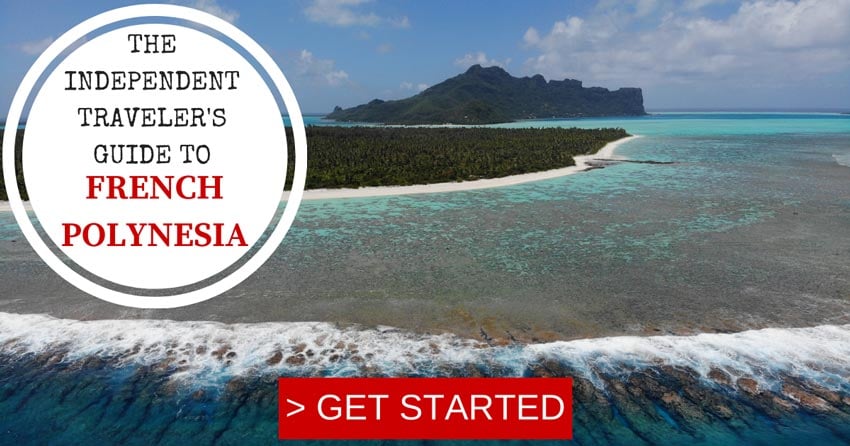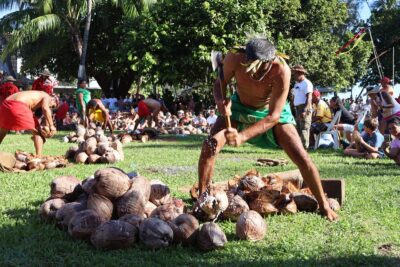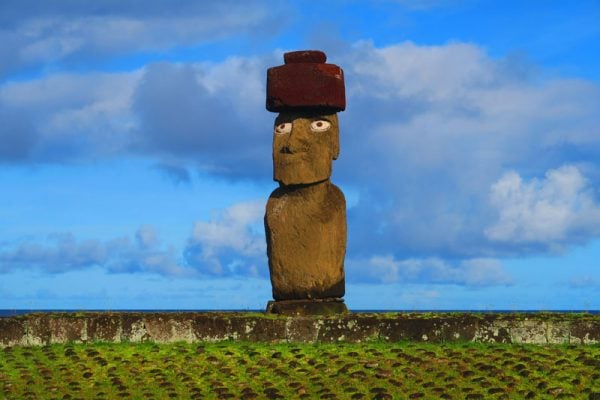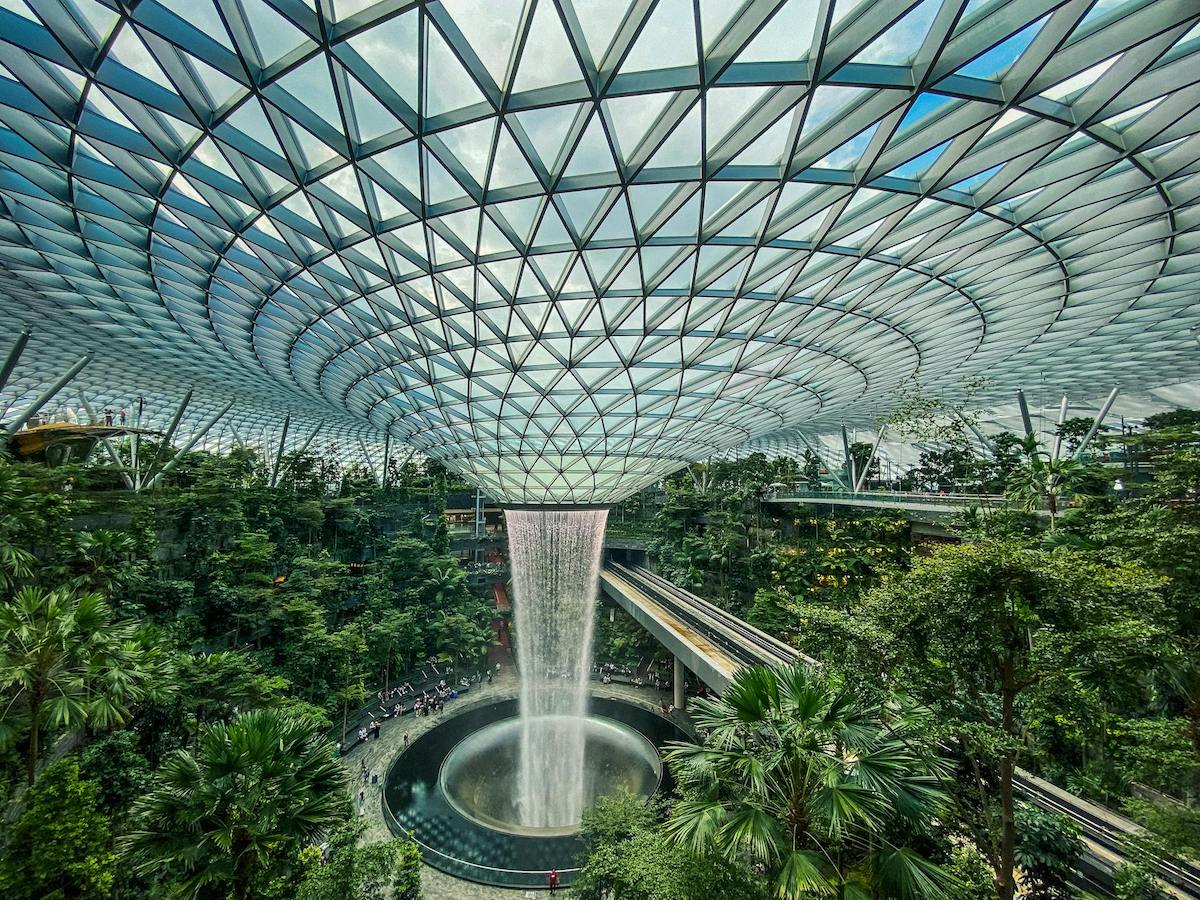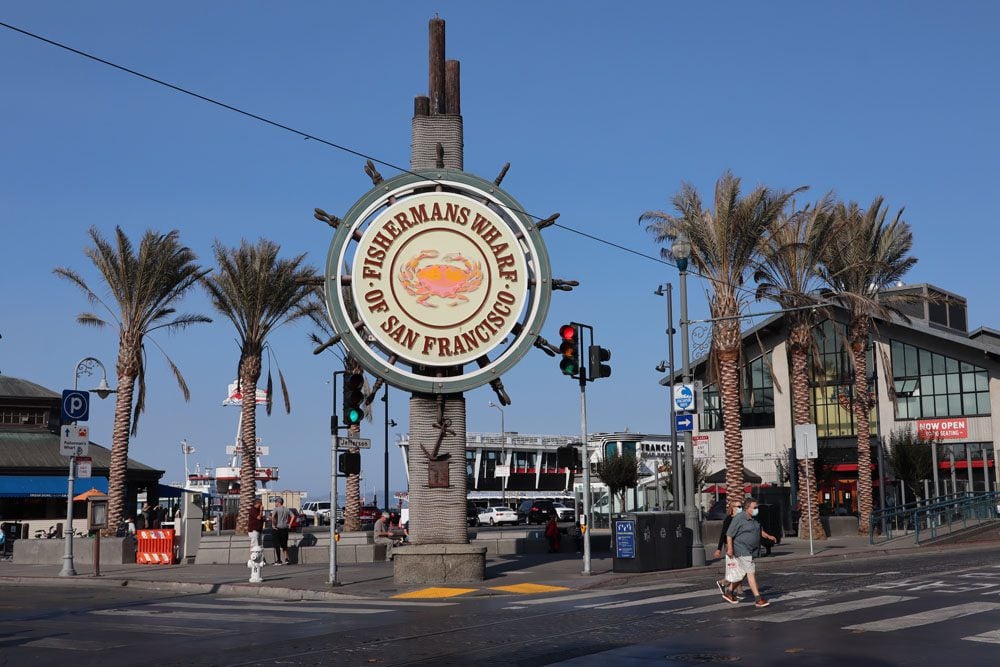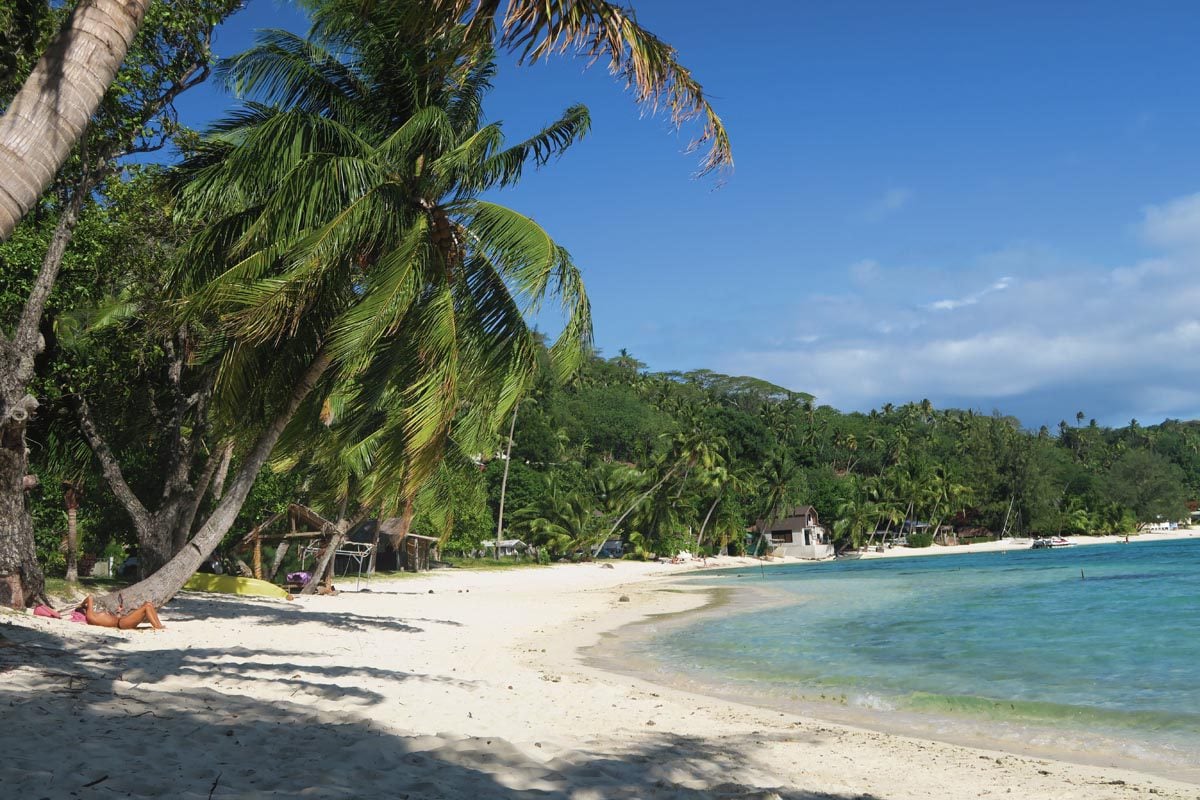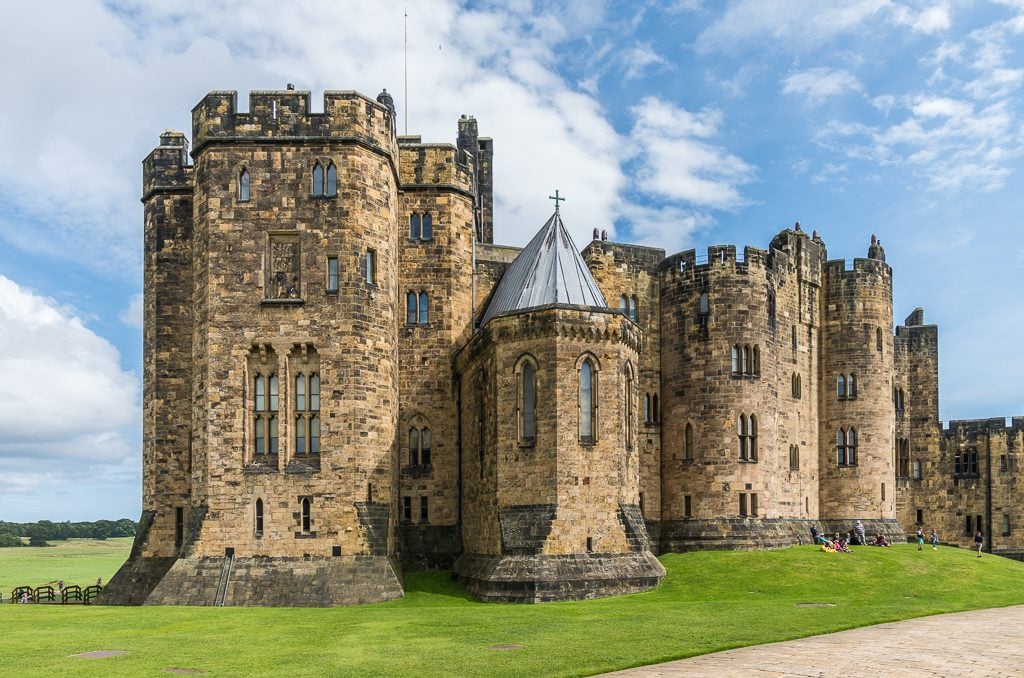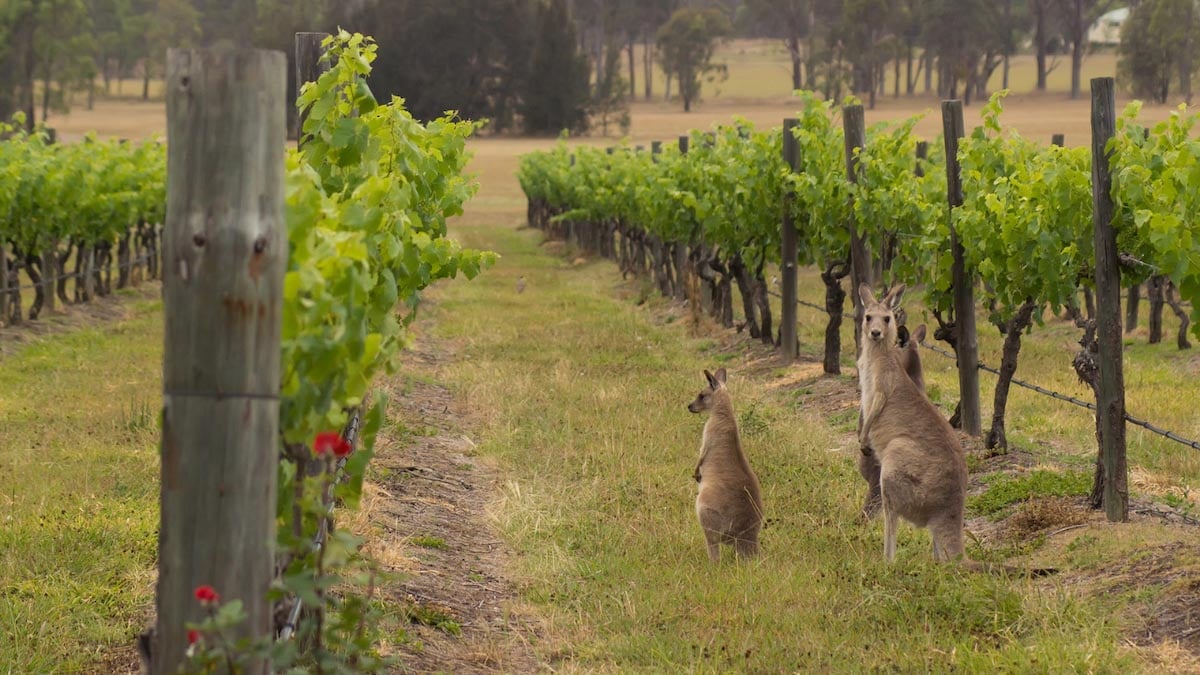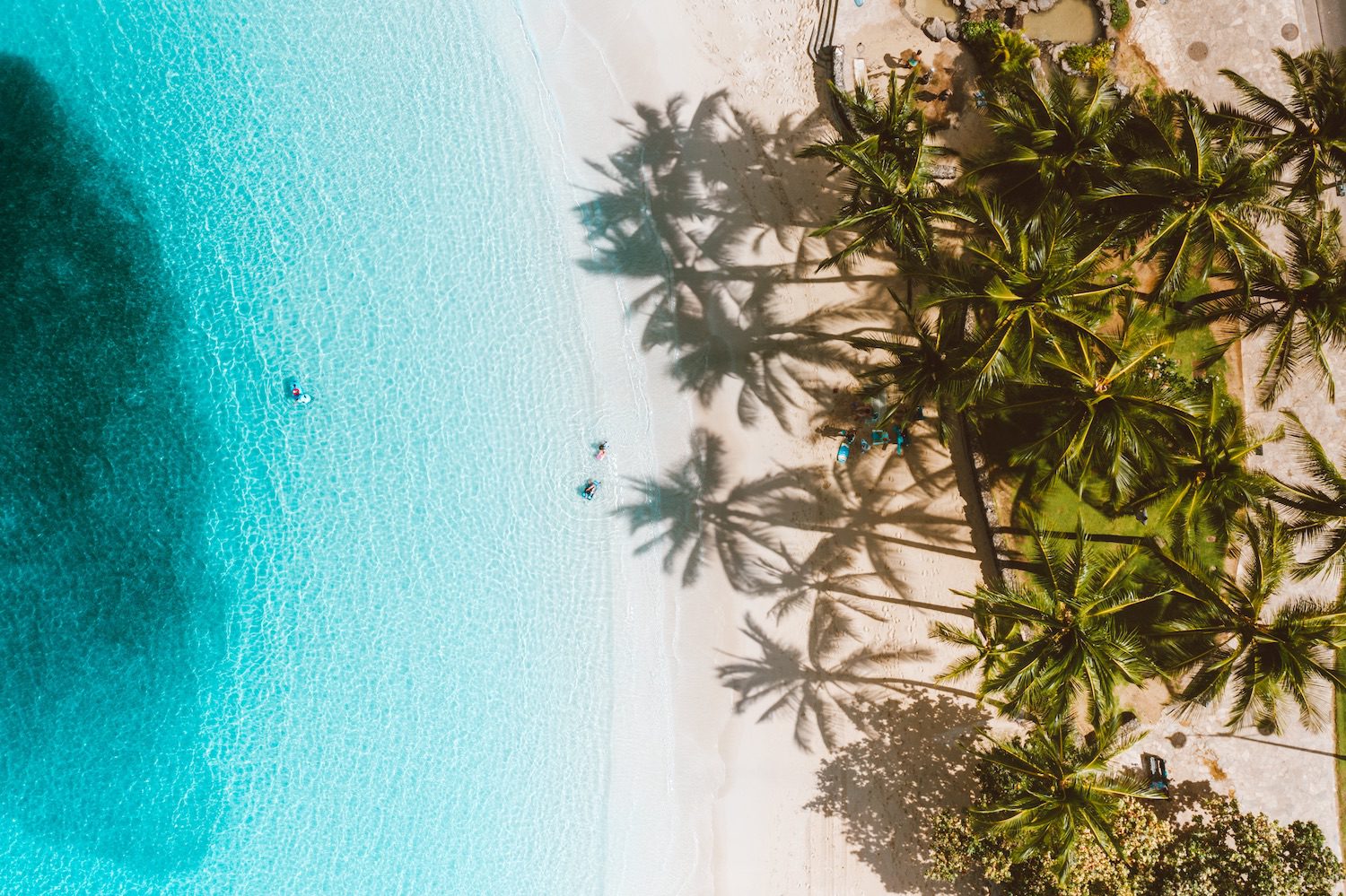Traveling in French Polynesia During COVID: Part 6 – Hiva Oa & Ua Pou
This is the story of a six-week island hopping journey in French Polynesia during COVID-19. In this post, we head to the territory’s wildest island chain. With dramatic nature on steroids, the Marquesas Islands are not the type of place for catching up on your sleep.
In the previous post, we wrapped up the tour of the Austral Islands in Tubuai and Raivavae. In the sixth (and second last) part of the series, we return to the Marquesas Islands and begin the tour with a quick stop in Hiva Oa before taking the most dangerous flight in French Polynesia to the island of Ua Pou.
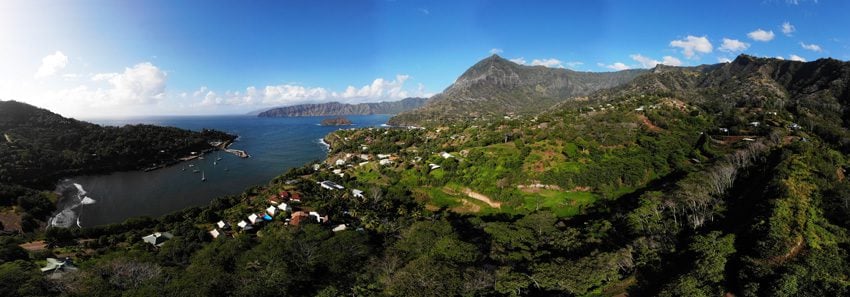
COVID update in French Polynesia: this was my fifth visit to French Polynesia, this time traveling during September and early October. Infections were few when I arrived but the numbers gradually rose by the time I had left. After a sharp spike in confirmed cases and deaths, the increase seems to have leveled off. An evening curfew is still in effect in both Tahiti and Moorea but the government has affirmed its intention not to return to a second lockdown. French Polynesia’s borders are still open for tourists under specific conditions.
Heading to French Polynesia? In-depth island guides to all 5 archipelagos await you, including sample itineraries and essential travel tips & tricks.
The Marquesas Islands
When you imagine a Polynesian island in the South Pacific, you most likely picture a blue lagoon, white sand beaches, and overwater bungalows. And you are quite right. Most islands in this beautiful and remote part of the world are exactly like your stereotypical vision of a tropical paradise. Now forget about all of that and let’s talk about the Marquesas Islands. The coconut palms are still here but that’s just about where the similarities end.
The Marquesas Islands are the northernmost archipelago in French Polynesia, approximately 1,500 km north of Tahiti and just 10 degrees south of the equator. The group consists of six inhabited islands from a total of 15, but the population barely tops 10,000, or less than 4% of French Polynesia’s total population. Unlike their sisters in the other four archipelagos, the Marquesas Islands are dramatically different. These high islands have no protective lagoon. Their high peaks and deeply eroded valleys create some of the most dramatic natural scenery in the world. Due to their isolation and the high cost of airfare, few tourists make it out here, but those who do are treated to a lasting experience.
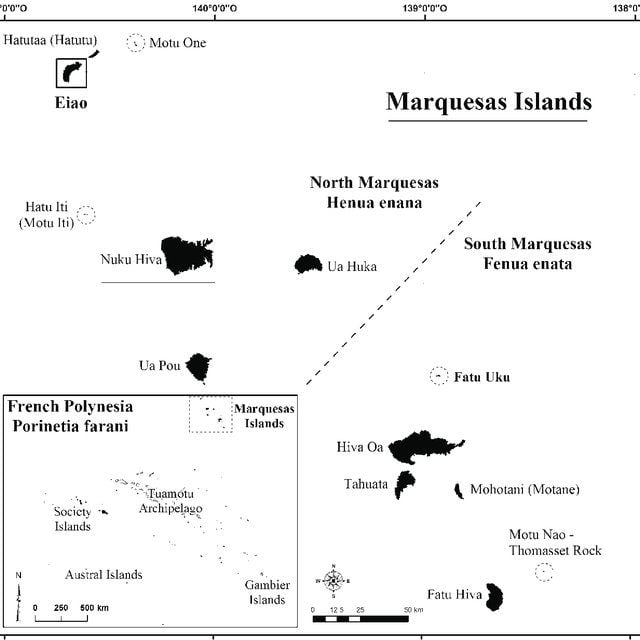
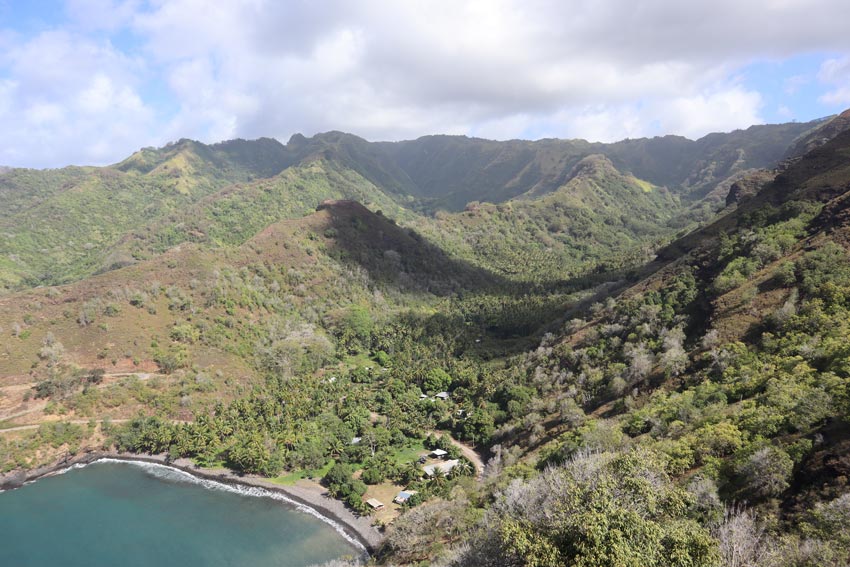
But it’s not only the archipelago’s wild nature that will leave you dreaming about the Marquesas Islands long after you’ve left. Known as The Land of Men (Te Henua ʻEnana or Te Fenua ʻEnata), the people of the Marquesas are as authentic as they come. Fishing, horseback riding, hunting, and tattooing are part of everyday life for islanders. Proud of their heritage, unique language, and historical land preservation, the people of the Marquesas Islands make it easier to imagine what life could have looked like in this paradise a few centuries ago.
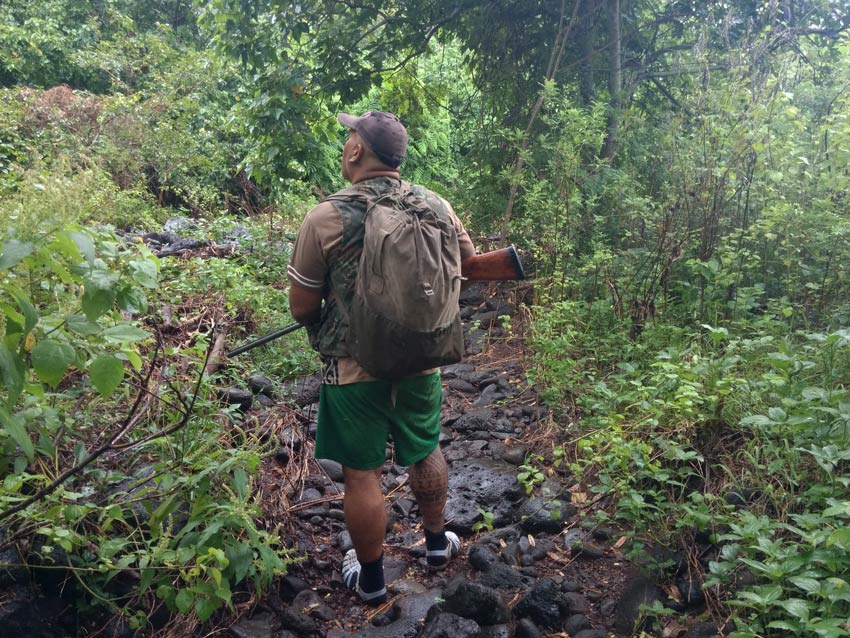
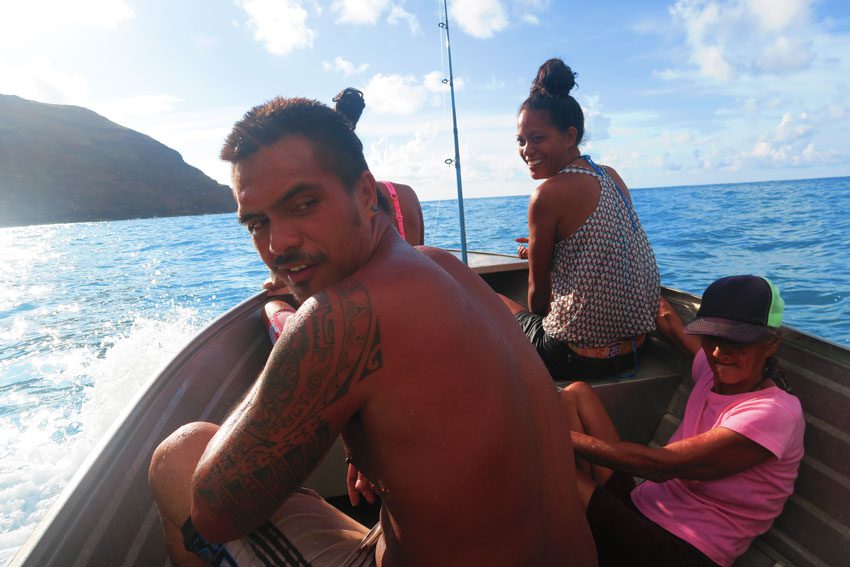
But if that’s not enough, the islands’ ancient temples are the best preserved in the South Pacific, topped only by the ones found on Easter Island. Though early contact with European explorers introduced diseases that decimated the native population and missionary endeavors successfully converted them to Christianity, the islands’ deep valleys are still home to stark reminders of the glorious ancient past.
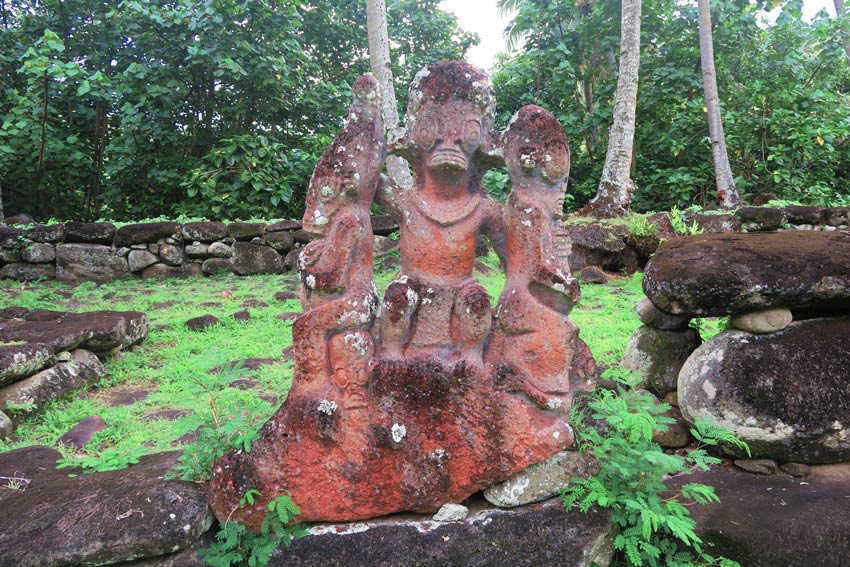
Kaoha Hiva Oa!
This is my second journey to the Marquesas Islands, having visited on the last leg of a six-month voyage across the South Pacific back in 2015/6. This trip sparked my fascination with Polynesia and I’ve since made four additional visits to the remote region. My plan on this journey was to visit for the first time the island of Ua Pou and a return trip to Nuku Hiva, but to reach Ua Pou, I would need to overnight in Hiva Oa, the island where my initial voyage came to an end.
Joining me on this leg to the Marquesas Islands was Dricia, my local friend from Tahiti whom I road-tripped with to the far side of Tahiti at the start of the trip. The Marquesas Islands are so far from Tahiti and so expensive to reach that most residents of Tahiti only dream about visiting. For about the same price, they can fly to the U.S. or New Zealand.
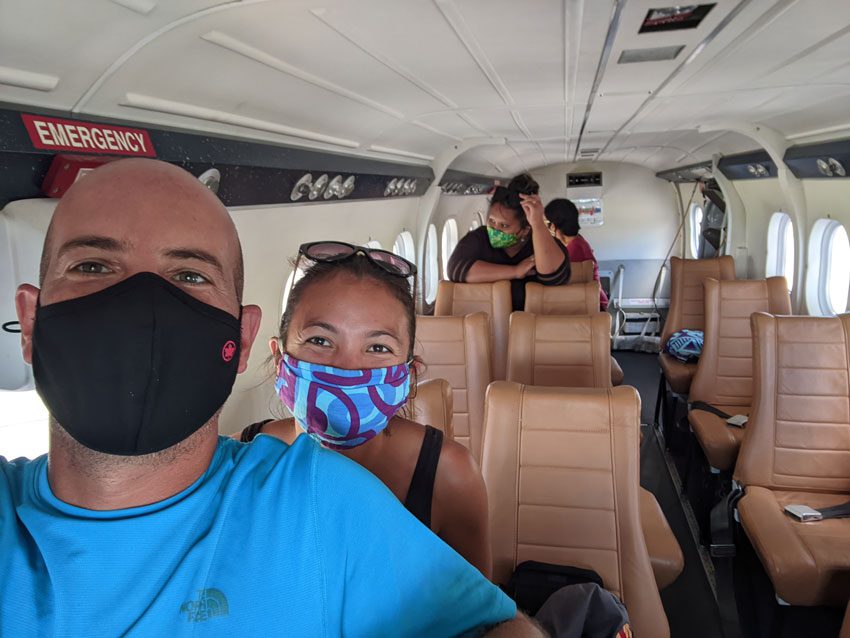
The flight from Tahiti took about 3.5 hours and our clocks needed to be adjusted ahead by 30 minutes. Such is the isolation of this wild archipelago from the rest of the French territory. We would also need to change our vocabulary as the local dialect is completely different than elsewhere. No more ia ora na (hello), only kahoa from now on!
At the tiny airport, I was reunited with Tania Amaru, the owner of Pension Kanahau. For me, Tania is the “queen of Hiva Oa”, an energetic and positive lady who goes above and beyond for her guests. Her pension offers superb ocean views and her smile immediately lights up every space. Upon arrival, Tania shows us just how “challenging” mango season has been this year, with football-size ripened fruit breaking plastic tables and chairs when falling off the tree.
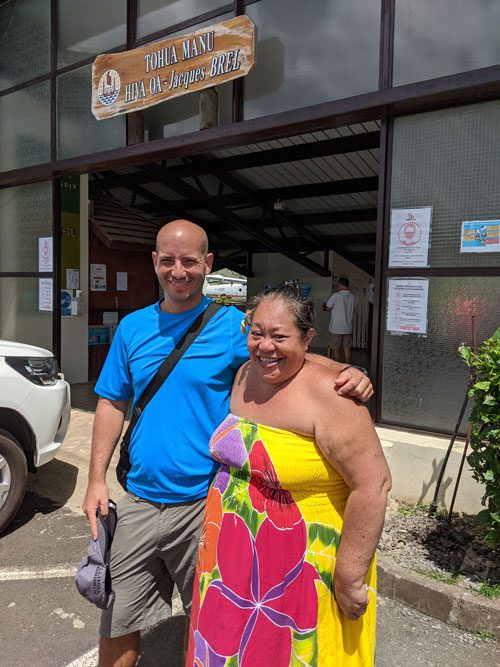
Searching for Tiki
With less than a full day on the island, there was no time to waste. After settling in, I was reunited with Pifa O’Connor, another local character who would take us on a road trip to the far side of the island to Pumau and the Lipona archeological site, where the largest and best-preserved tikis in French Polynesia still stand. As you may have noticed from his last name, Pifa has some Irish blood in him. His great grandfather settled in Hiva Oa and the O’Connors are now a large tribe. Pifa speaks perfect English and his signature move is chanting traditional Marquesan hymns from the bottom of his massive lungs, an experience you’ll never forget.
Before plunging to the far side of the island, we made a quick stop at a lookout from where the island’s lush rolling hills and neighboring Tahuata Island could be admired. We then embarked on a short hike in the rainforest to see the “smiling tiki”, a peculiar statue that resembles something out of an episode of Ancient Aliens. Nobody really knows why tiki is smiling here or why he’s wearing glasses.
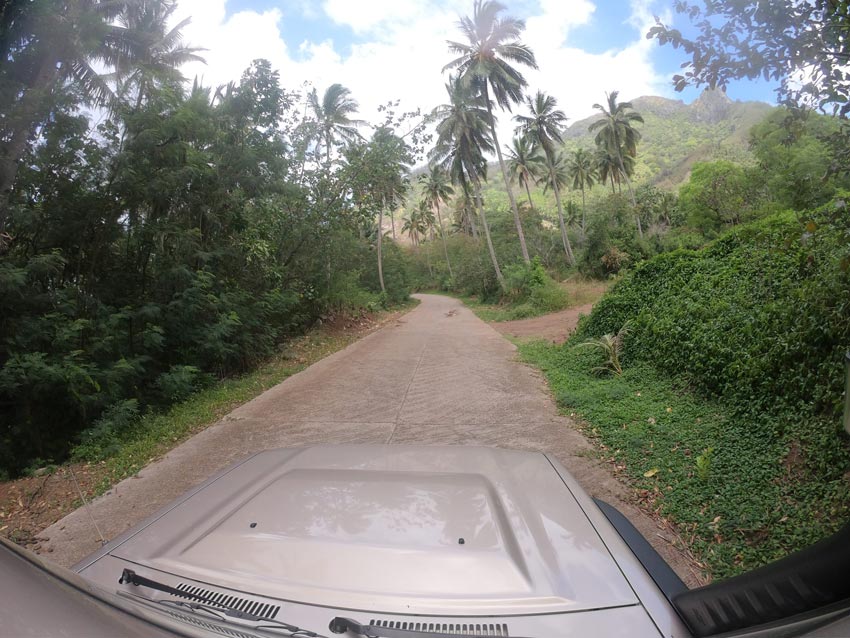
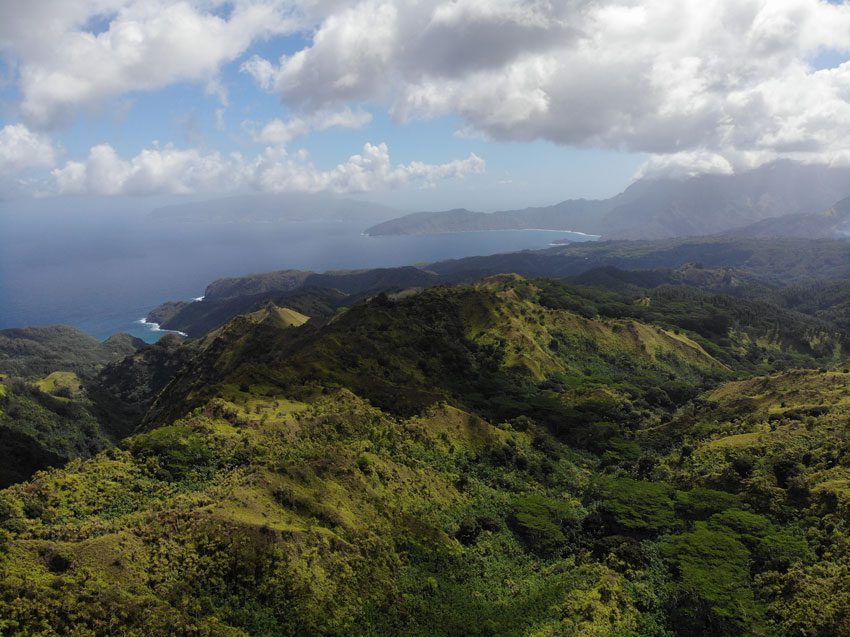
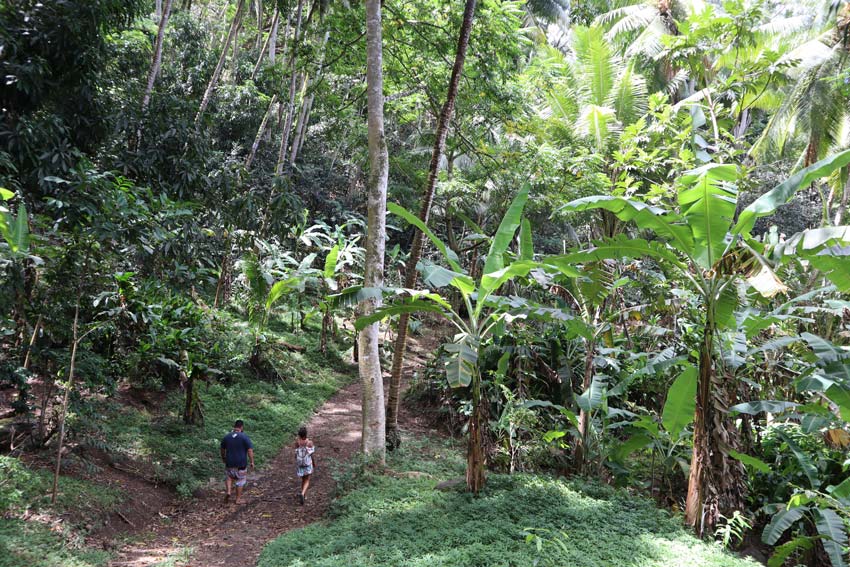
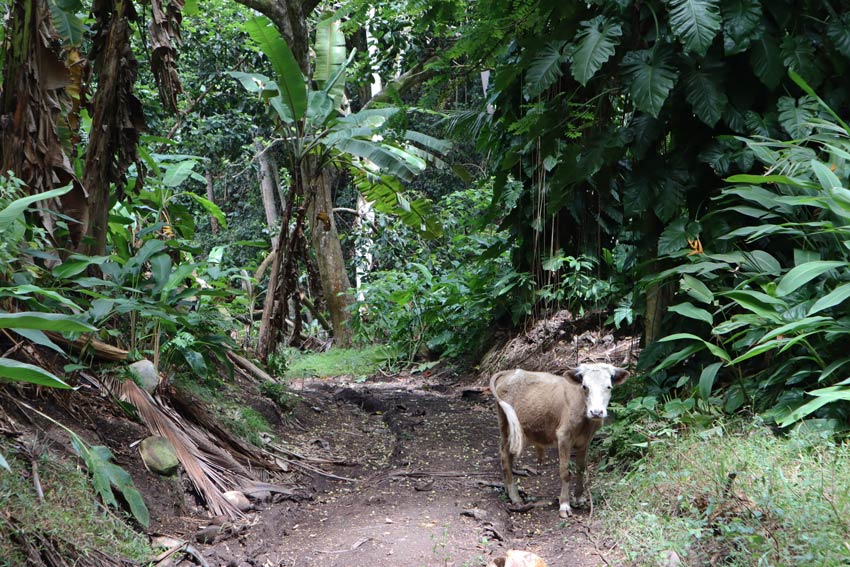
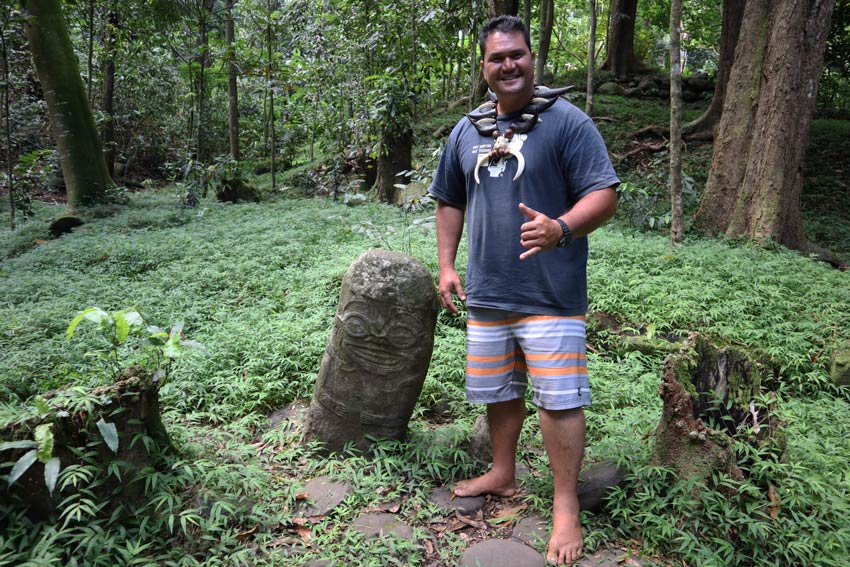
Pifa then shifted his newly-purchased pickup truck into low gear and we started the drive to Puamau. The 45 km journey used to take a full day to complete but most of the road has now been paved and the quicker drive on this short day was just what we needed as we could often stop and admire the wild beauty of the island’s remote coast.
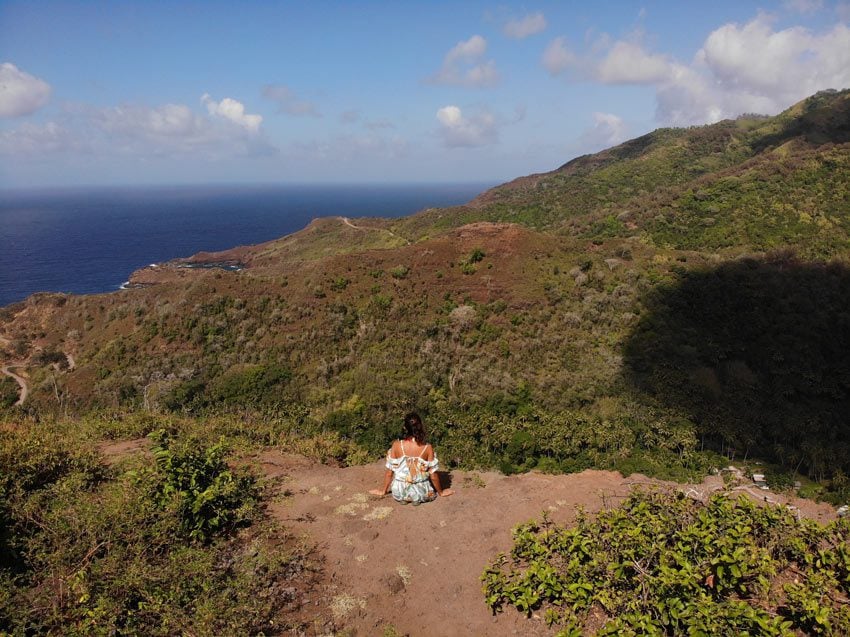
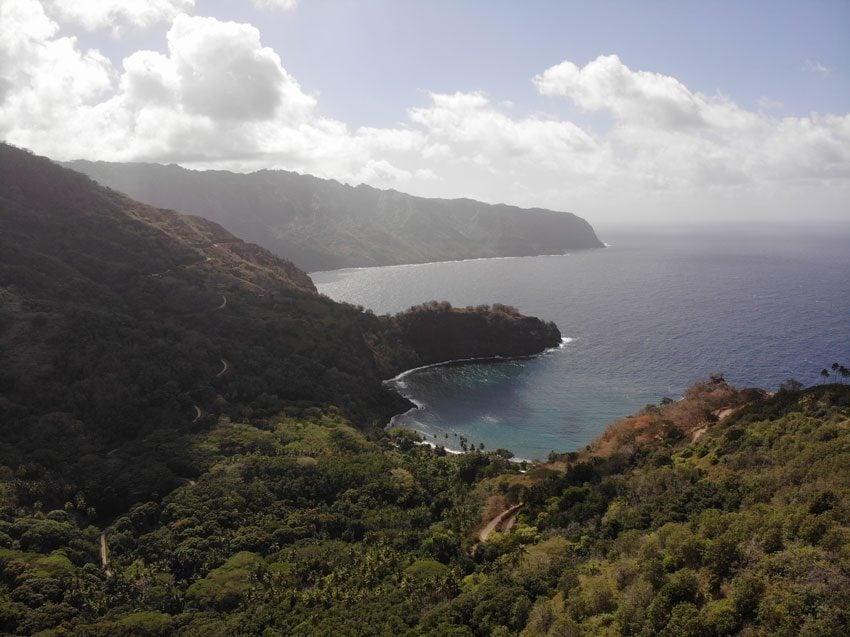
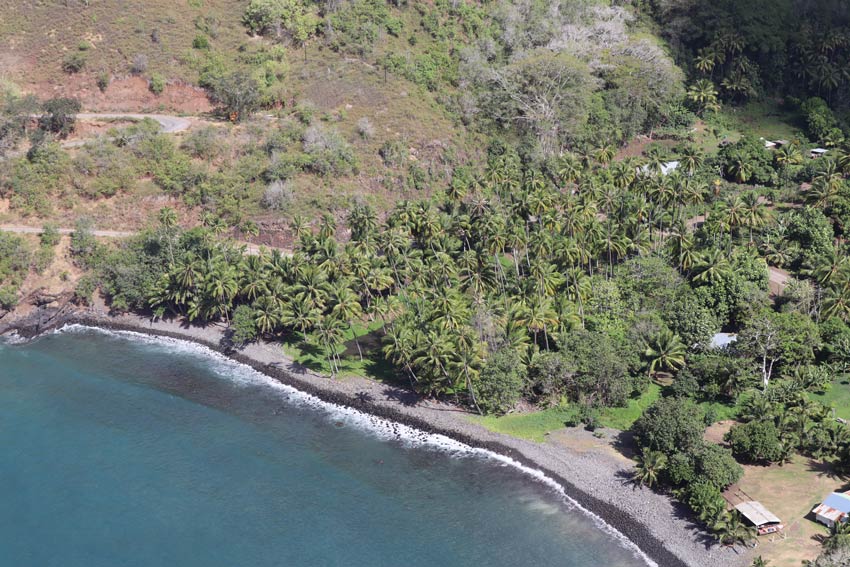
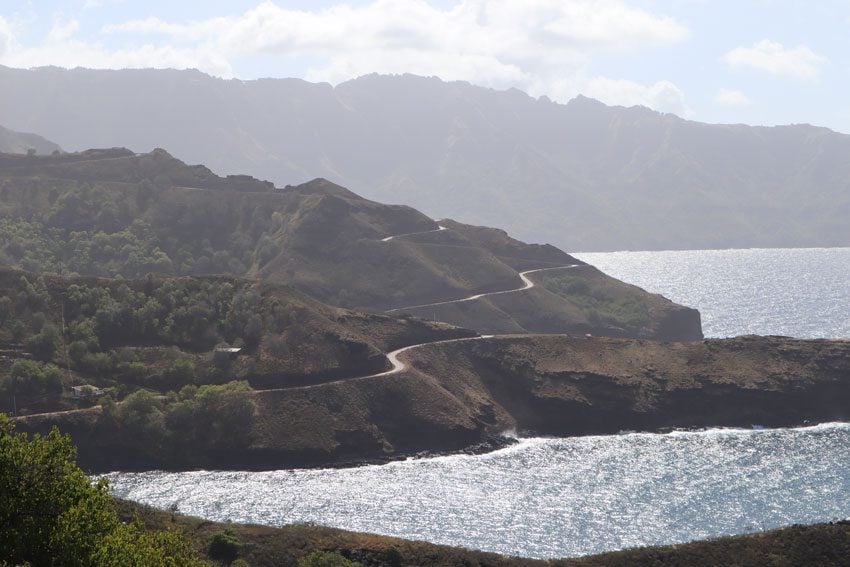
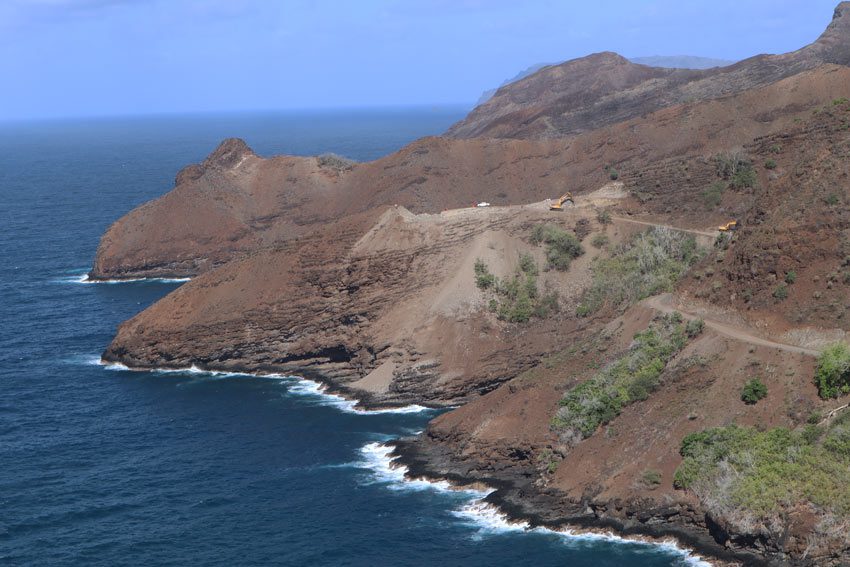
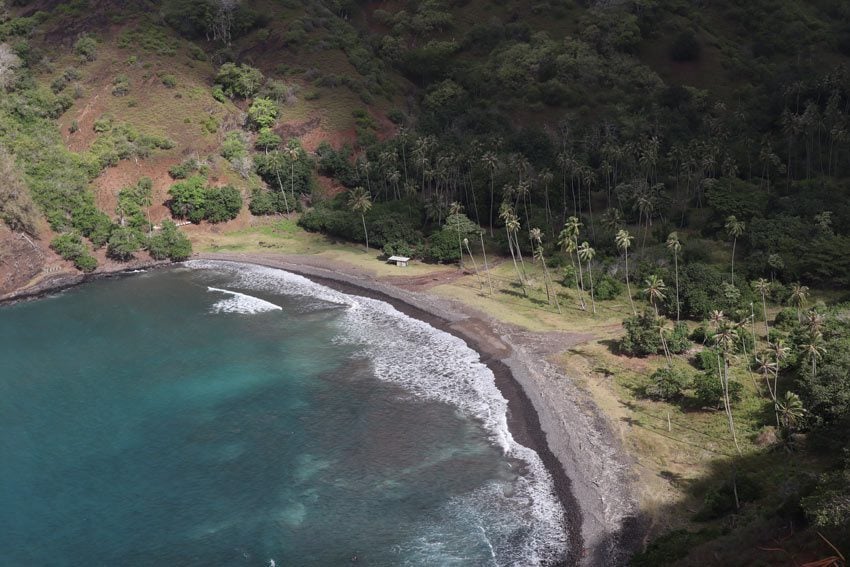
Puamau is the last village on the road and from here, we ventured inland to reach the Lipona Archeological Site. This ancient religious complex is scattered with original statues in all shapes and sizes, some of which rise to a height of two and a half meters! You can really feel the mana in this temple complex. Locals believe ancestral spirits are all around and I can’t blame them for feeling something special in the air. But even if you normally question the whole “spiritual thing”, six-fingered statues, extremely rare female figurines, and crouching alien-like beings depicted giving birth to goats, should get your goosebumps going. This site is currently undergoing preservation work in the hope to become a UNESCO World Heritage Site in the near future.
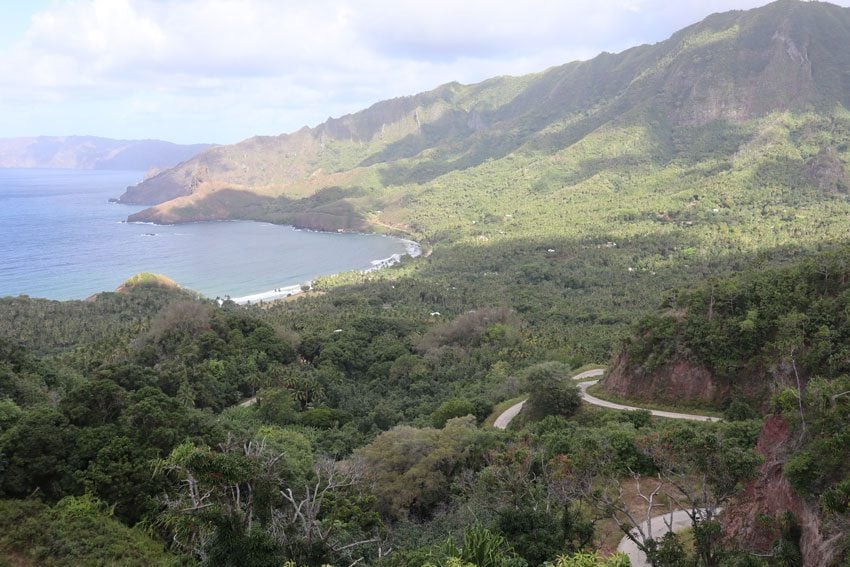
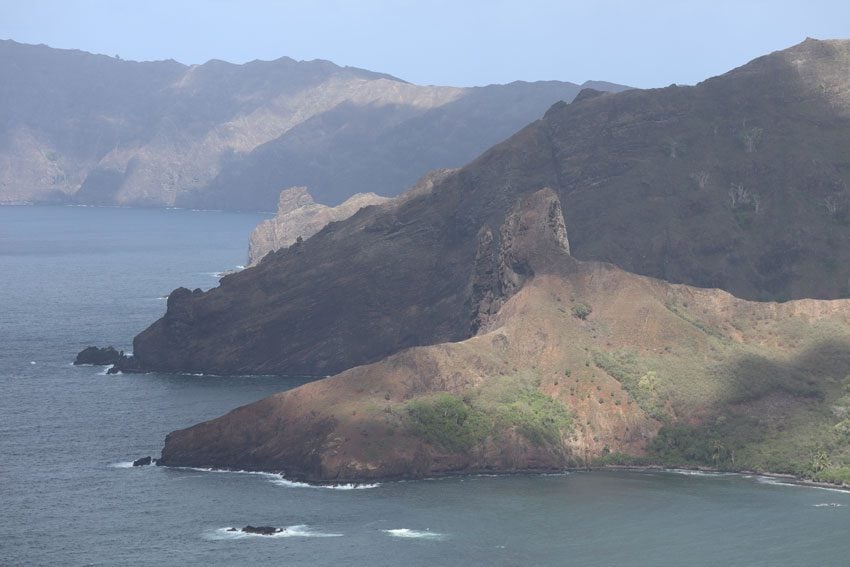
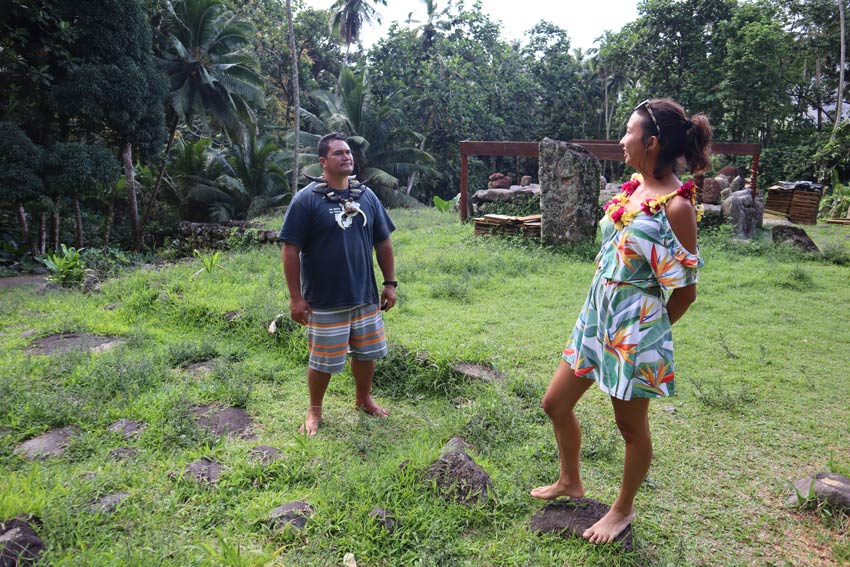
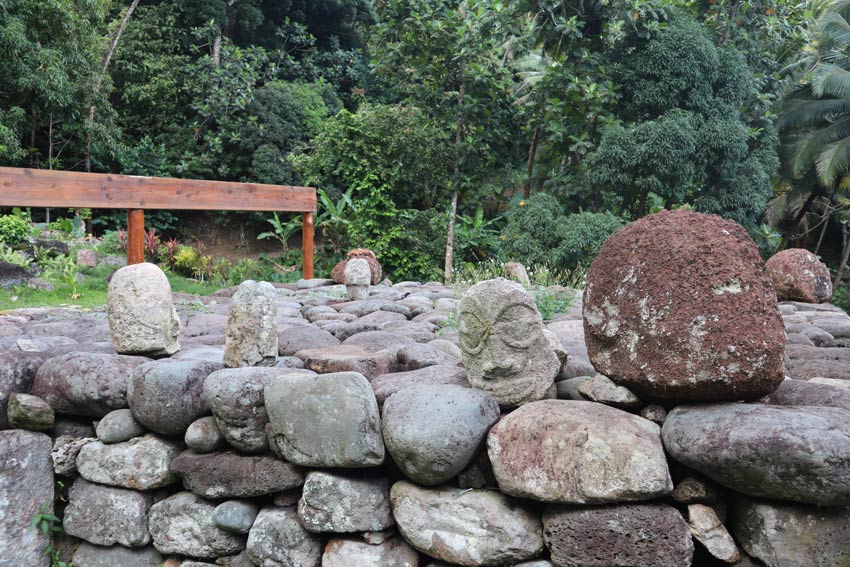
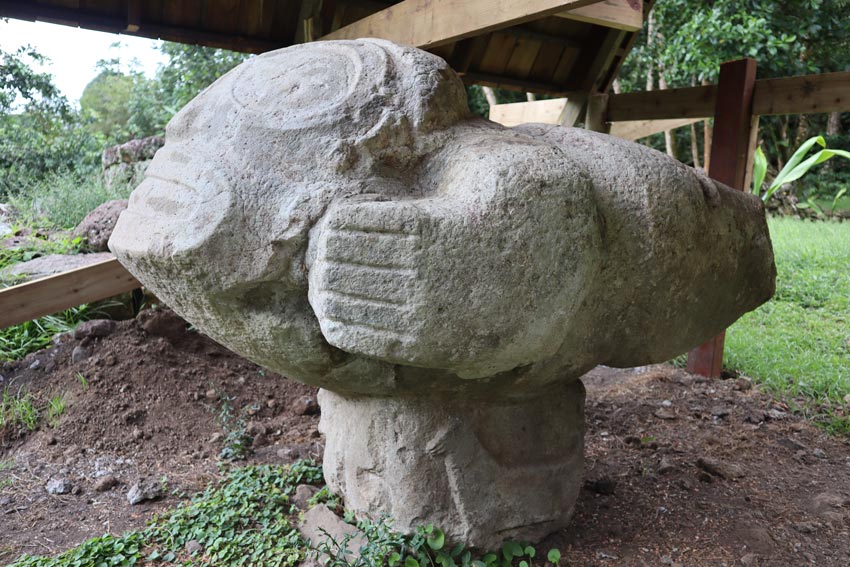
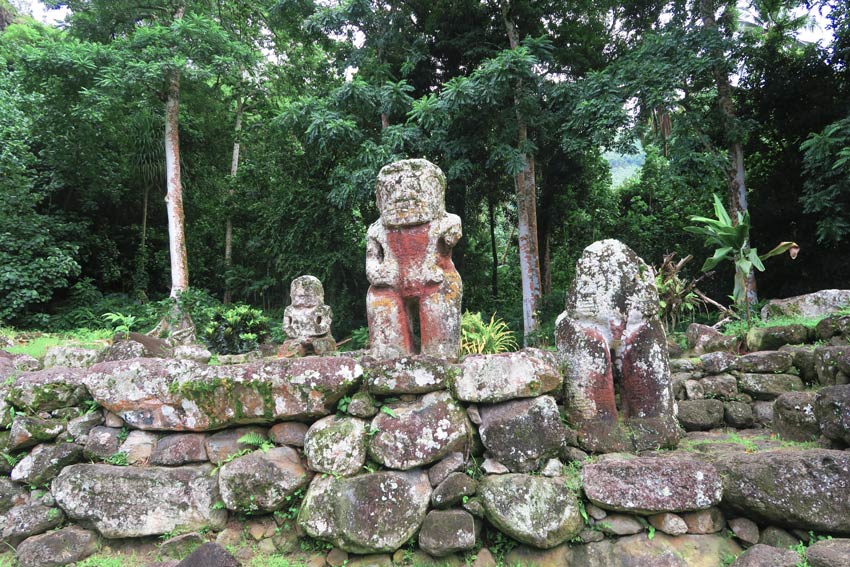
On the way back, we stopped at Pifa’s village, Hanaiapa. It was late Sunday afternoon and the scene was straight out of a fantasy film. Children were splashing in the river, others were playing volleyball, and families were chilling on the shores of the rocky beach. We picked up Pifa’s wife and son and headed for dinner to wrap up this special day.
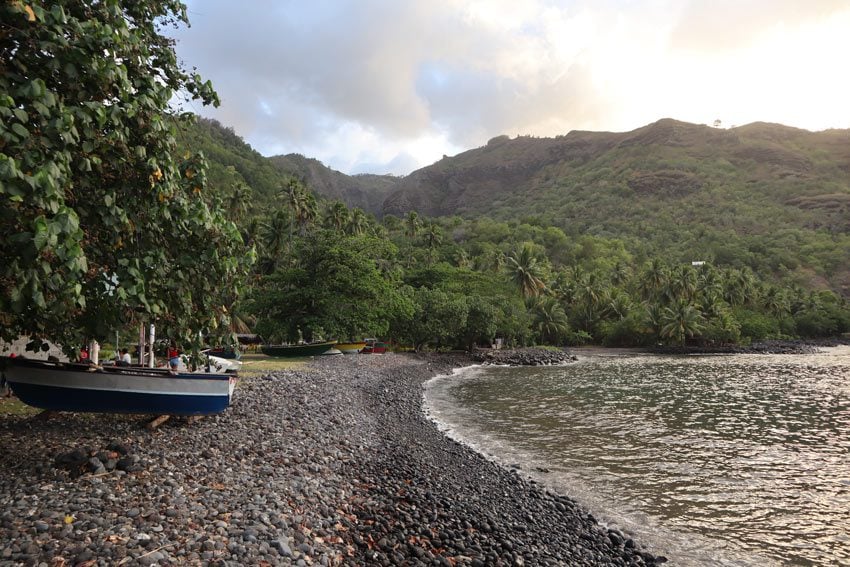
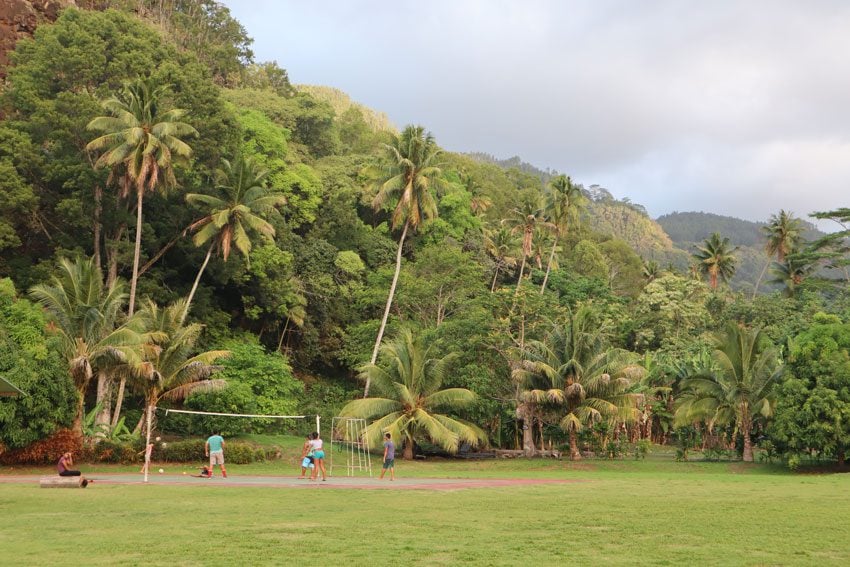
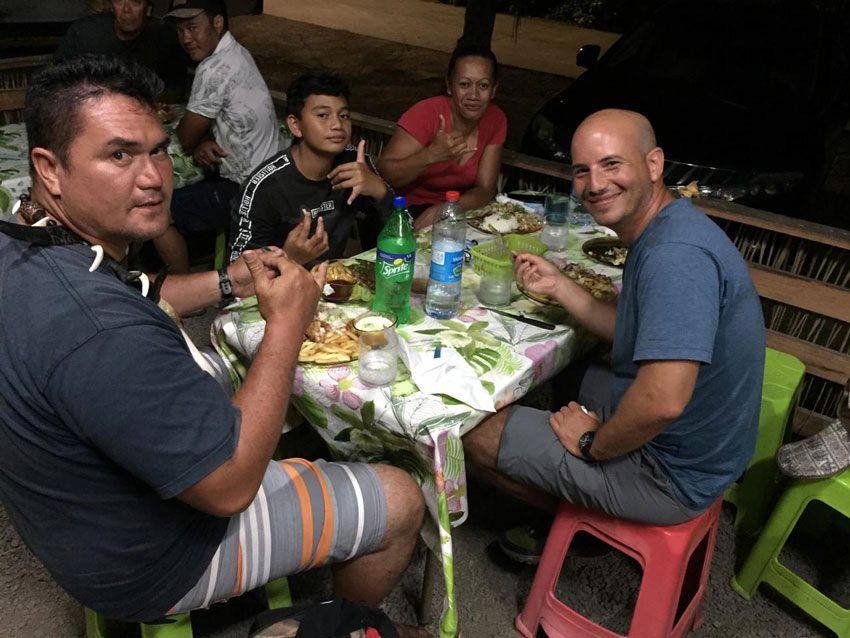
The Most Dangerous Flight in French Polynesia
After a breakfast of homemade jams and coconut bread baked by Tania, we had one last task in hand before departure. Hiva Oa is where French painter Paul Gauguin and Belgian singer/actor Jacques Brel lived their final years. Both are resting at the Calvary Cemetery just above the island’s main village, Atuona. We made the short pilgrimage to honor the two and to get their blessing for the short but challenging voyage to our next stop, Ua Pou.
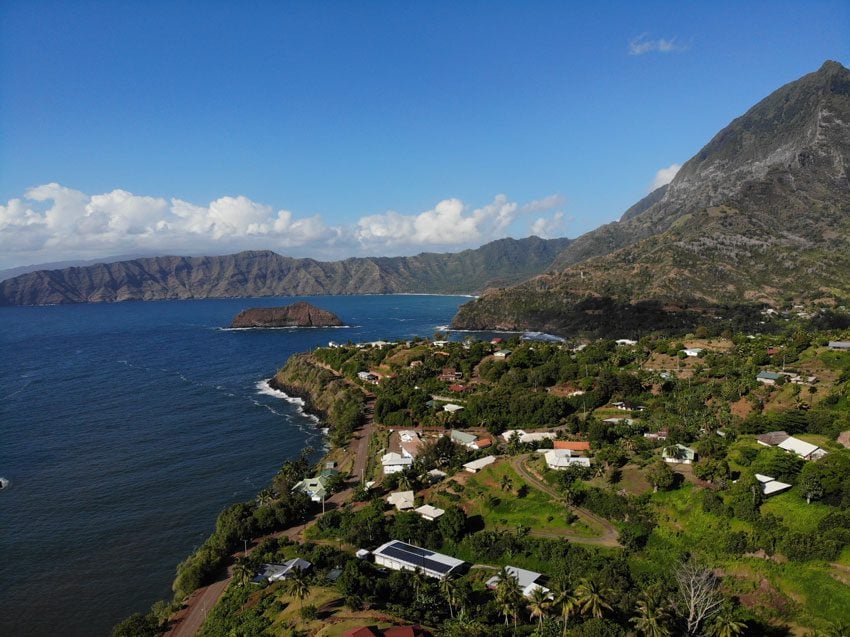
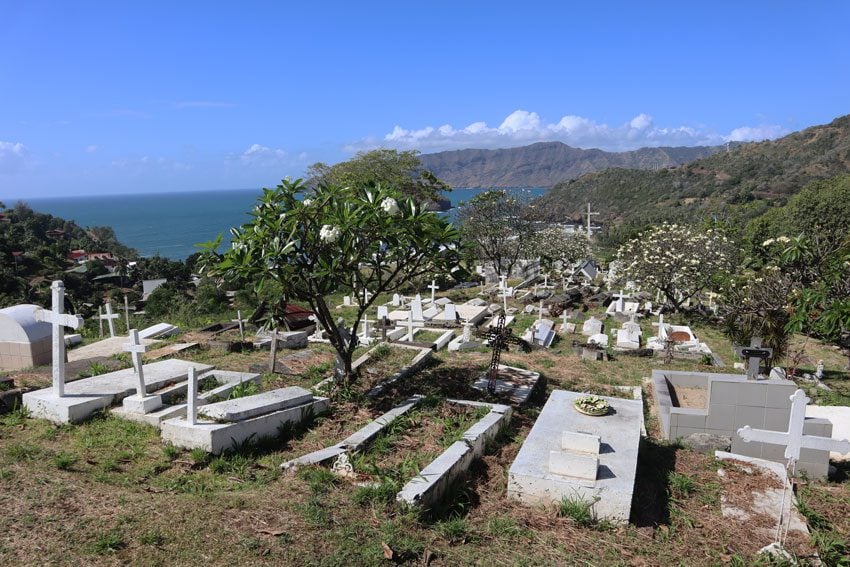
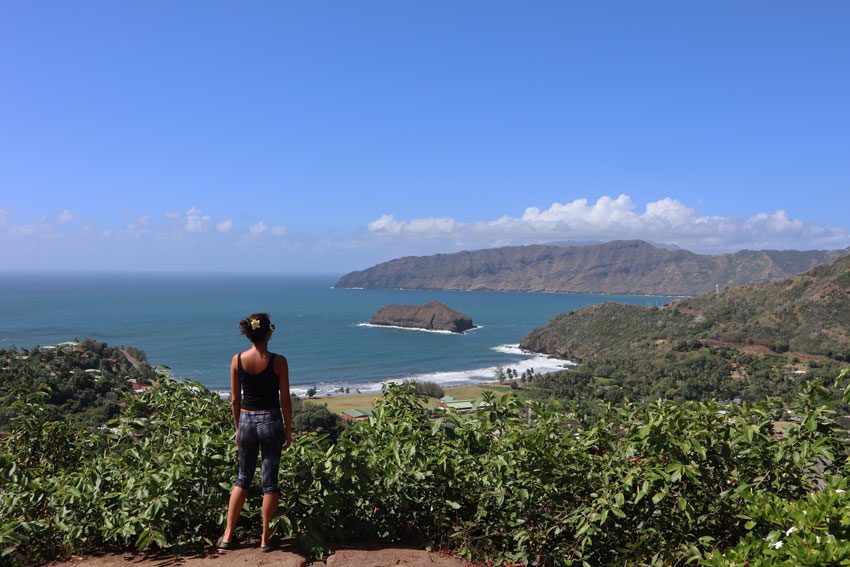
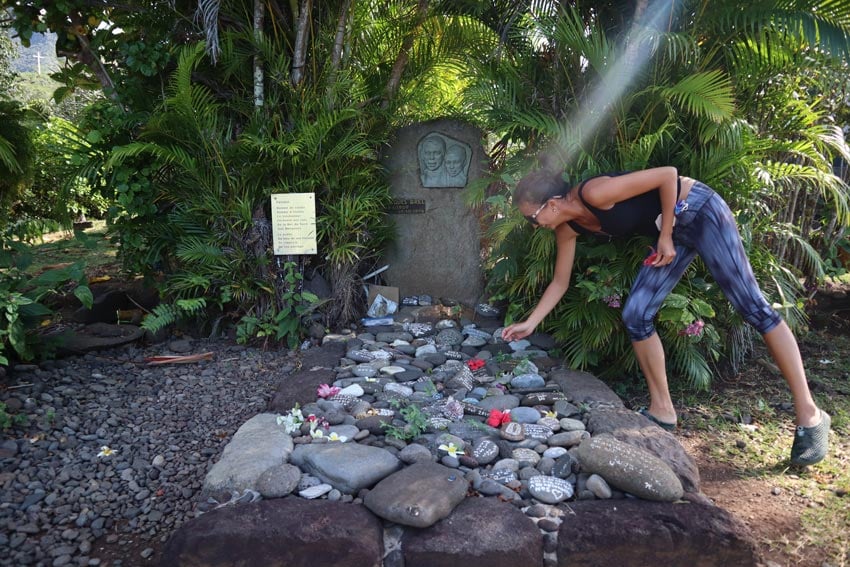
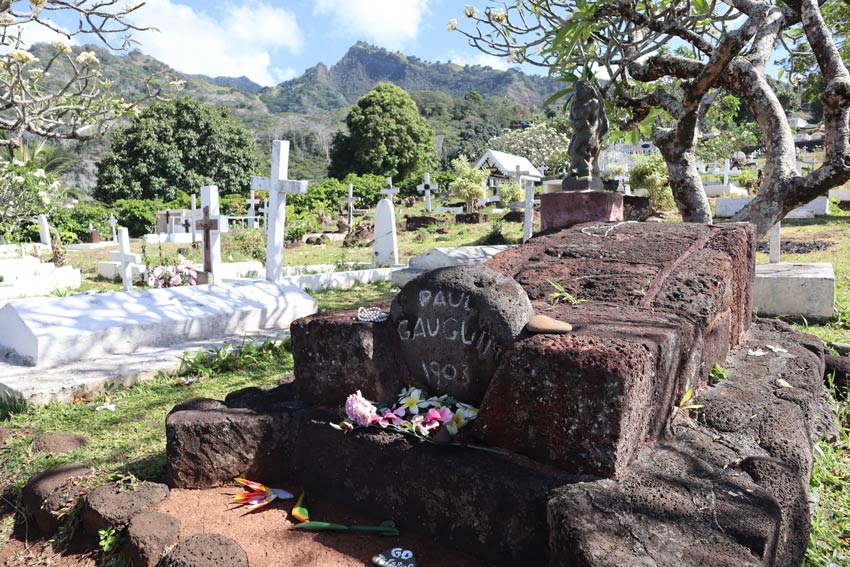
Ua Pou is the second most populated island in the chain but it was really challenging to install a runway here. As such, flights to Ua Pou are carried out on small Twin Otters with pilots having to overcome crossing winds to land on a short runway that needed to be paved with an upward slope to slow the plane down. Flights are prone to last-minute cancellations so we really needed Gauguin and Brel’s blessing.
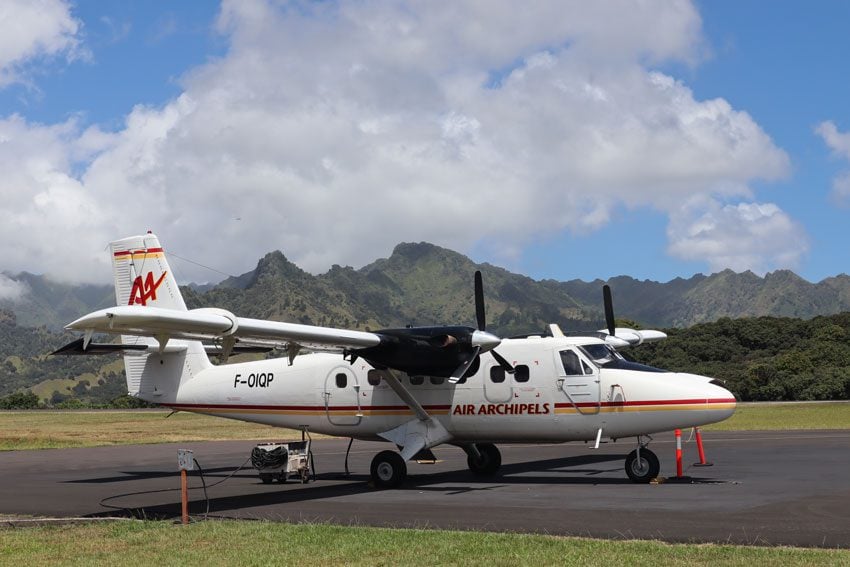
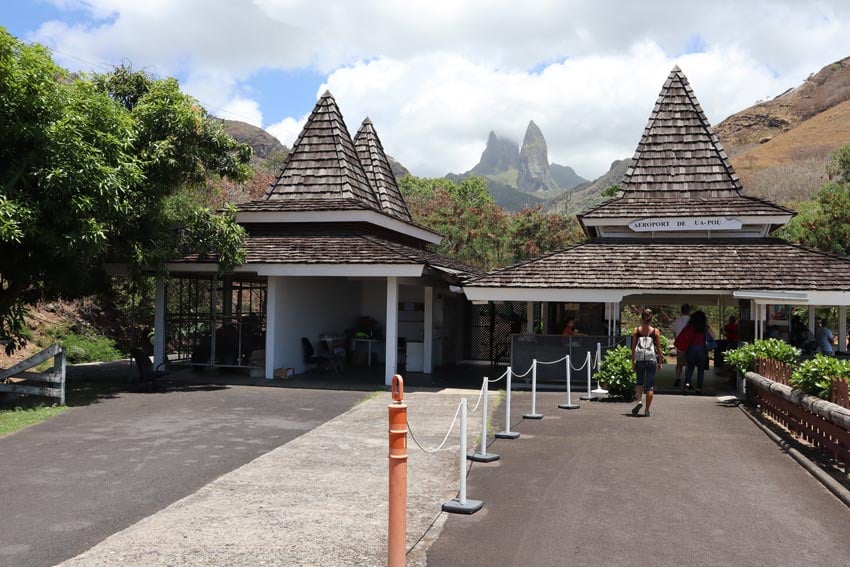
At the tiny airport, we were greeted with superb views of the island’s famous twelve basalt pinnacles and by our host Jerome Simonneau from Pension Pukue’e. After retiring from the French military, Jerome and his Marquesan wife, Elisa, built (not without many bureaucracy-related hardships) one of the finest pensions in French Polynesia, complete with a swimming pool, a well-stocked bar, delicious communal meals, and, above all, breathtaking views. We zig-zagged our way in Jerome’s 4X4 down to Hakahau, the island’s main village nestled on the shores of a horseshoe-shaped bay.
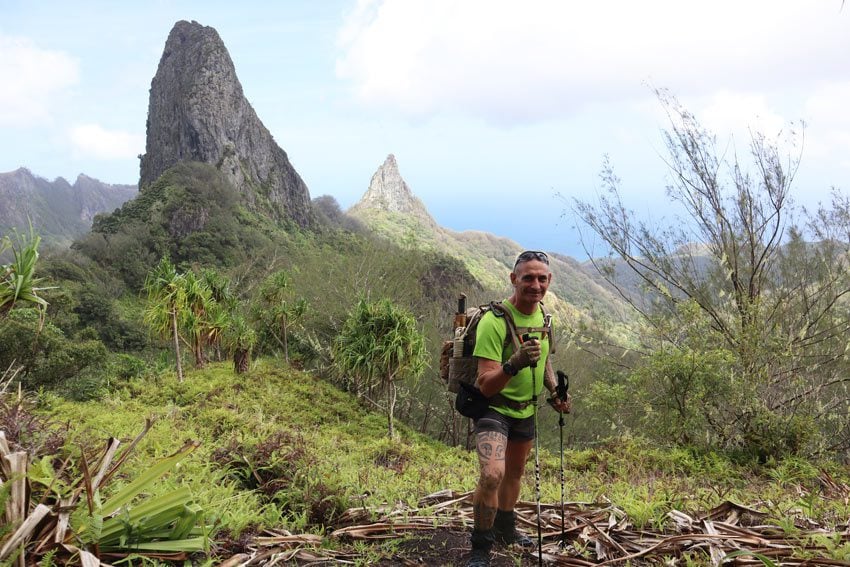
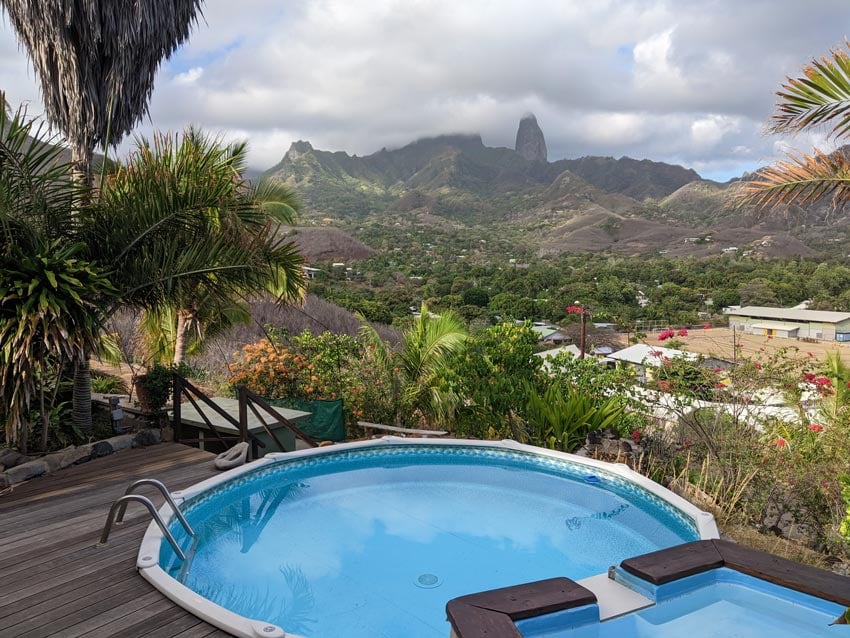
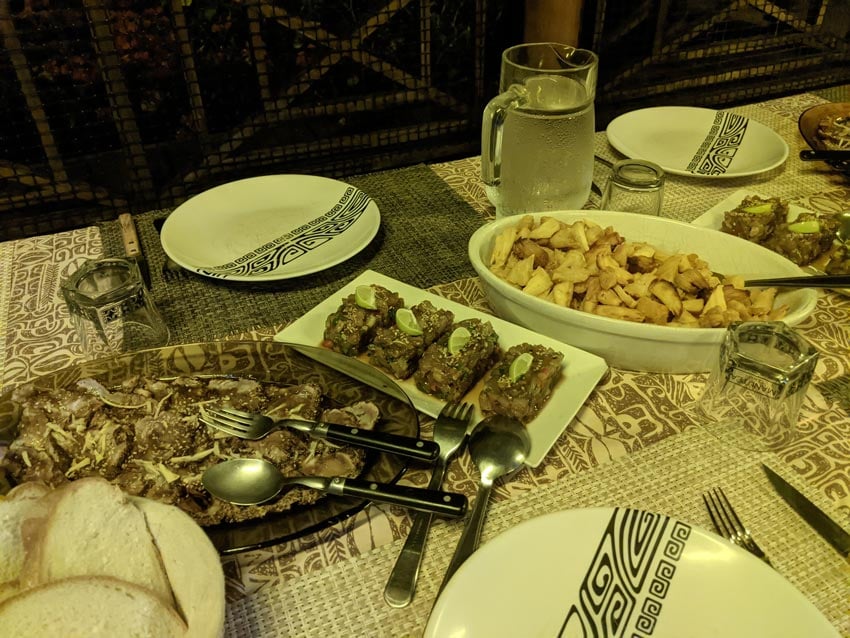
Getting Lost is Part of the Fun
With a few hours of sunlight left, Dricia and I went for a short hike using a hand-drawn map that Jerome gave us. We immediately notice how dry this side of the island is and later learn that it hasn’t properly rained in nearly two months. Apart from the main village, whose water supply is pumped from a series of inland dams, the rest of the island is on a serious water regiment, some having the taps on for just two hours per day. Unlike lush Hiva Oa, this island is like a sponge and unable to trap large amounts of groundwater.
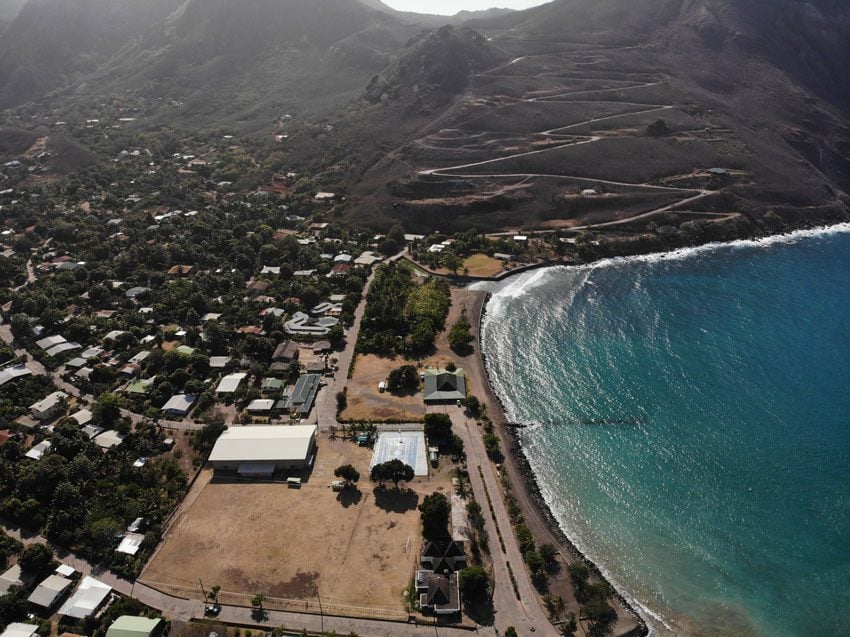
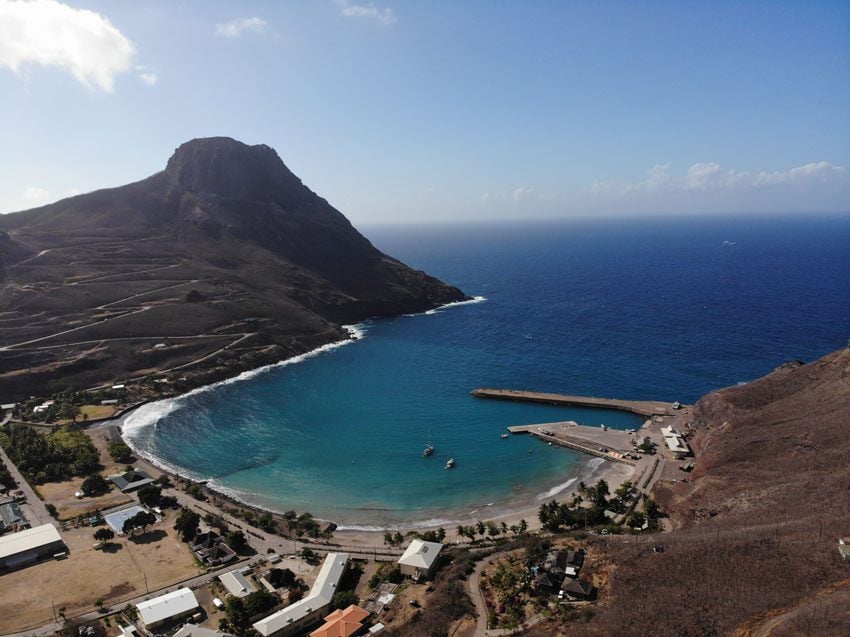
The trail took us to wild beaches, panoramic vistas, and close encounters with the island’s herds of wild cows and horses. Though Dricia was a perfect navigator, we eventually somehow made it to the wrong beach and were now faced with having to walk back. Lucky for us, all things do happen for a reason and at this beach, we met a local family who drove us back to town just in time for a glorious sunset. Marie, the family’s mother, came to visit a friend on the island 21 years ago and never left. Now teaching English, her two Marquesan daughters impressed us with their vocabulary and treated us to a performance of a local tune honoring the island’s waterfall.
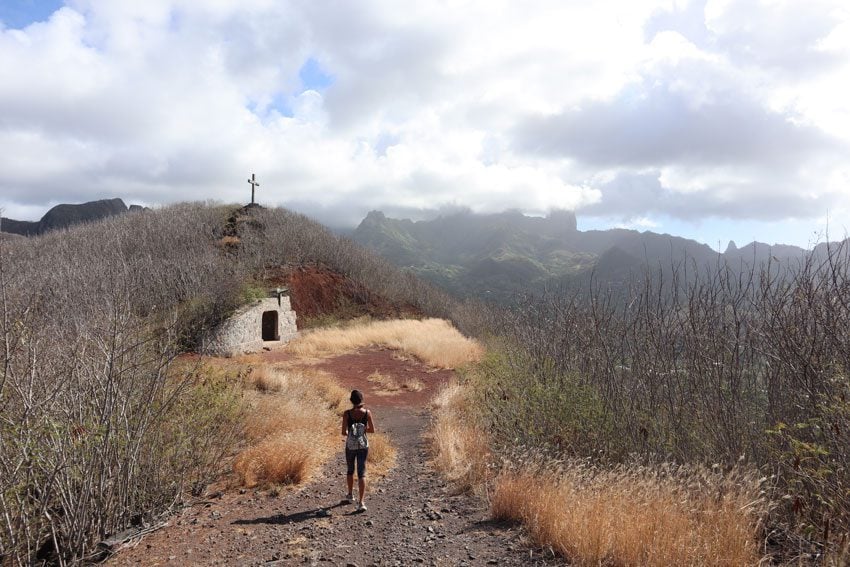
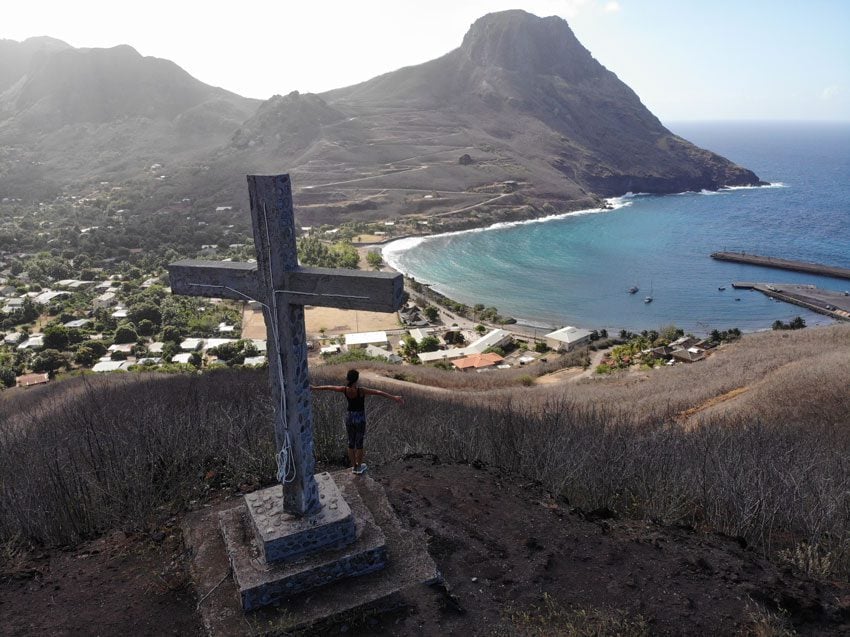
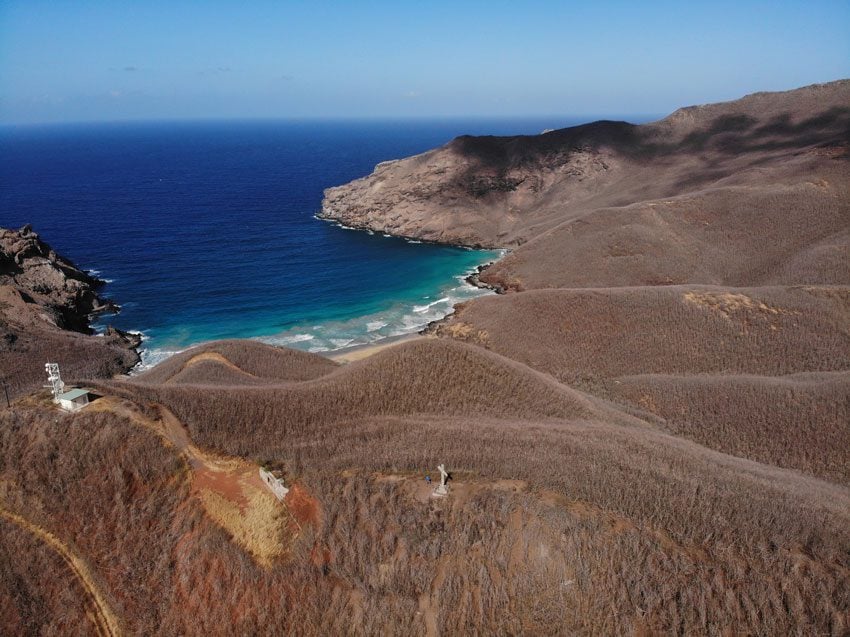
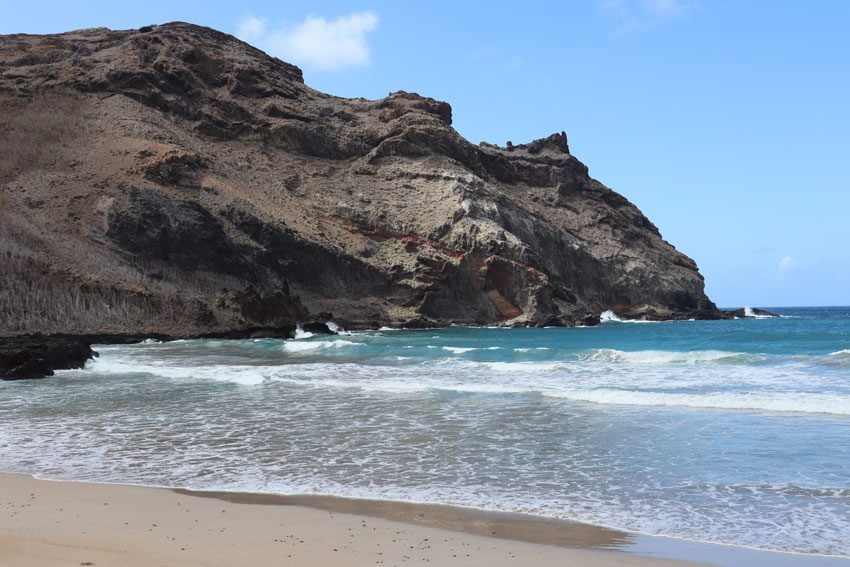
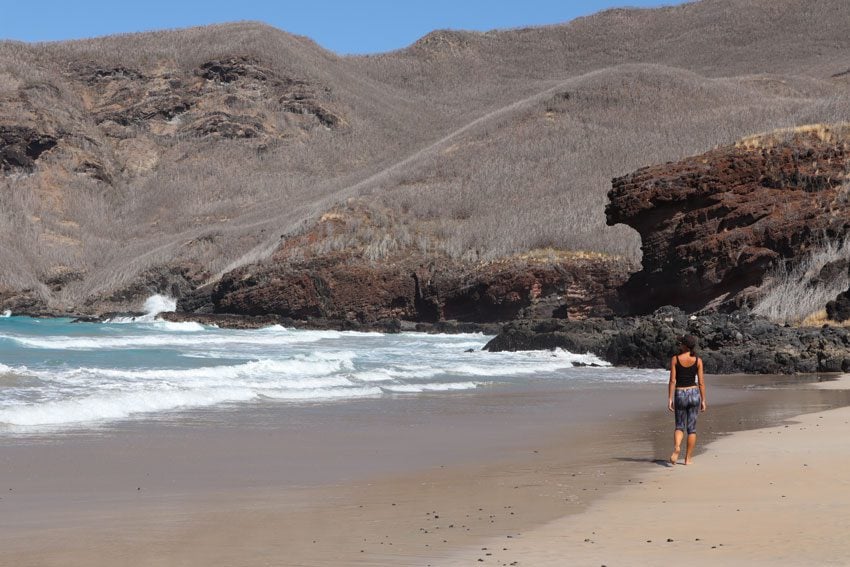
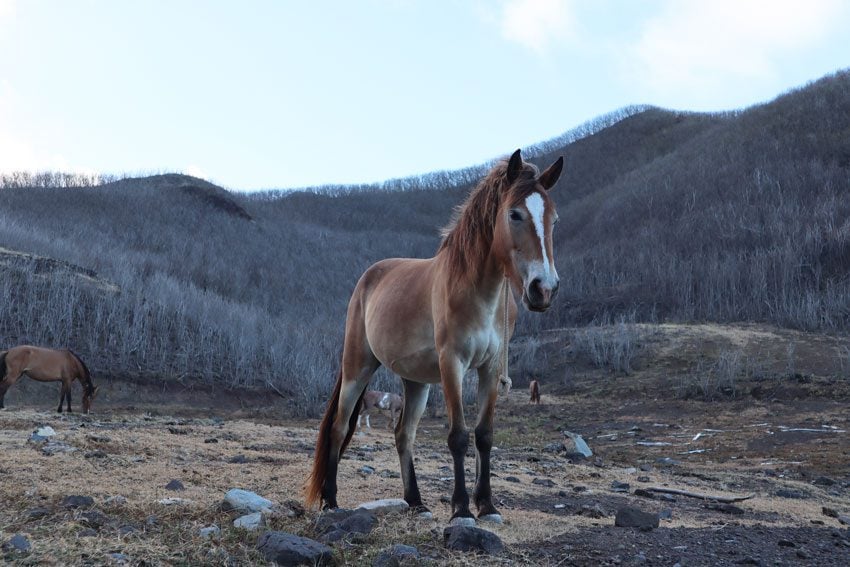
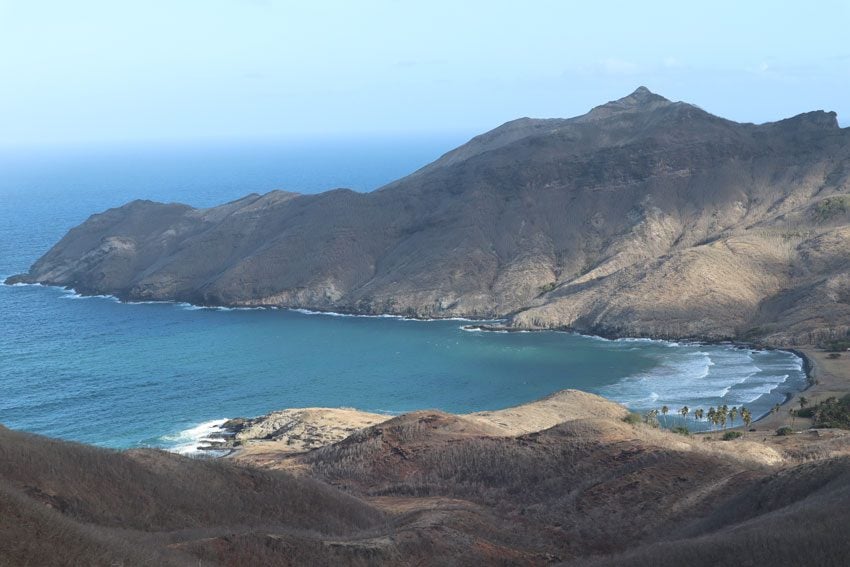
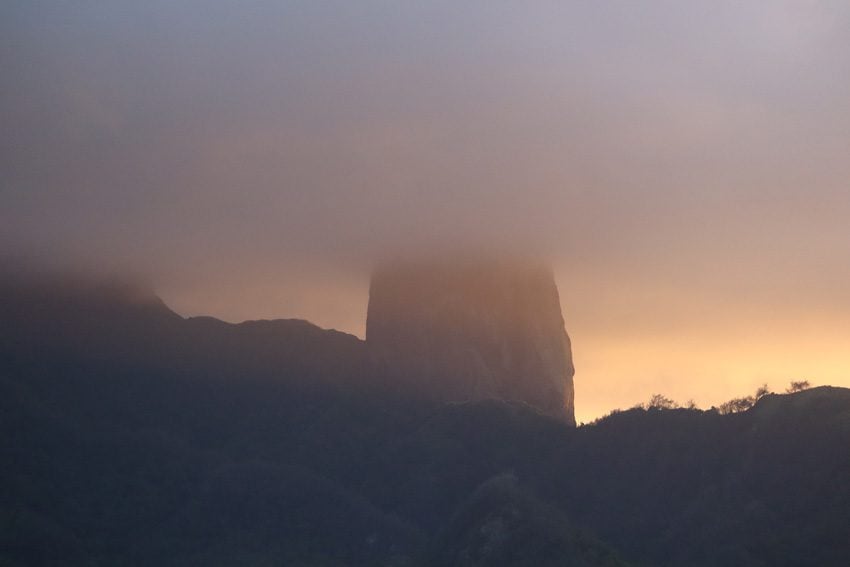
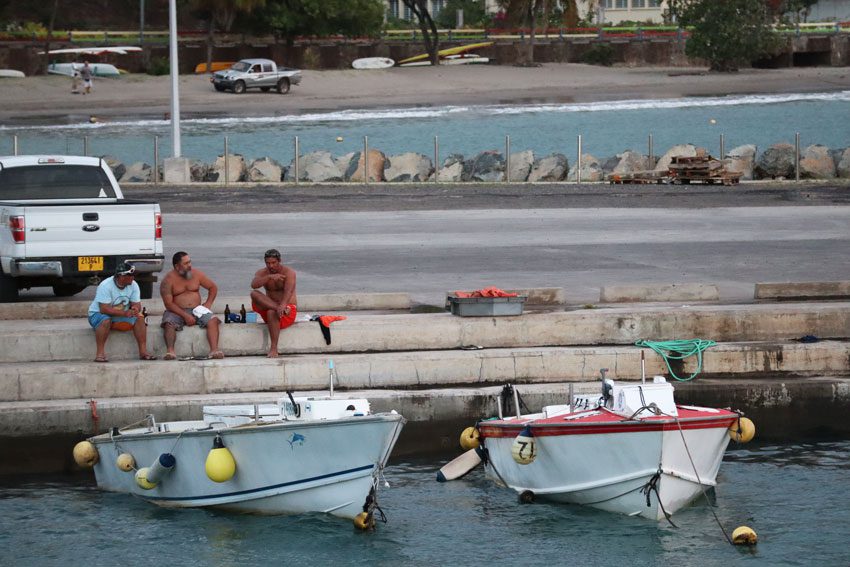
During dinner, we met the other guests staying at the pension and realized just how hard COVID has hit Ua Pou. Apart from one “sort of a tourist” from the island of Wallis, all other guests are administration workers from Tahiti who came here for various duties. Jerome and Elisa share with us that due to the scarce number of flights during pre-COVID days, Ua Pou gets few visitors as it is. The pandemic has only compounded this problem. Locals working in tourism have had to become creative to survive, and the future doesn’t look bright.
South of the Island
On the following day, Jerome took us to check out the wild southern part of Ua Pou. We had a feeling that he was a good guide but on this day, we learned that Jerome is simply a walking encyclopedia.
As we drove from one scenic lookout to another, Jerome explained to us the island’s interesting meteorology, geology, and how the twelve basalt pinnacles (pitons) had formed. We also learned about the ins and outs of life in Ua Pou. It turns out that some proud locals don’t even like to be called Marquesan since that was the name given to their archipelago by the Spanish back in 1595. We also learned that pregnant women must head to neighboring Nuku Hiva five weeks before their due date to prepare for birth-giving. Such is life on a remote island, things are never as easy as they first seem.
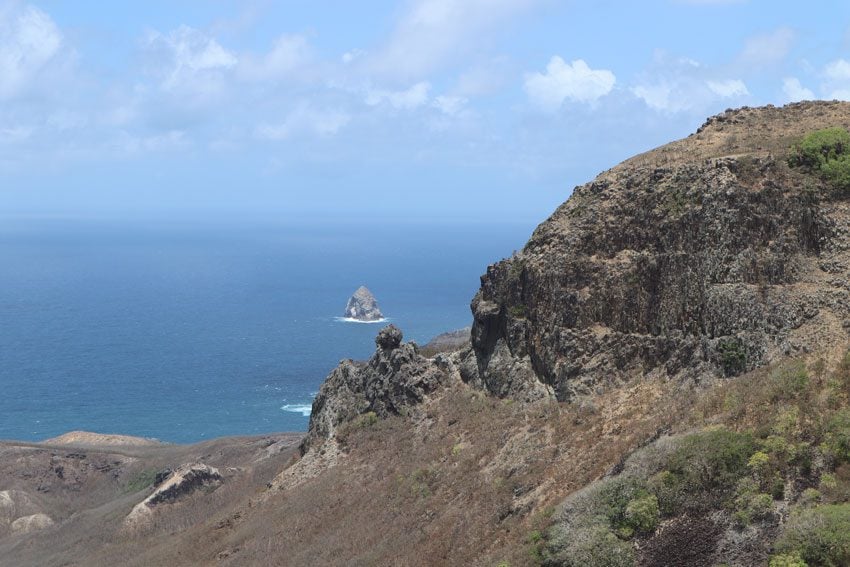
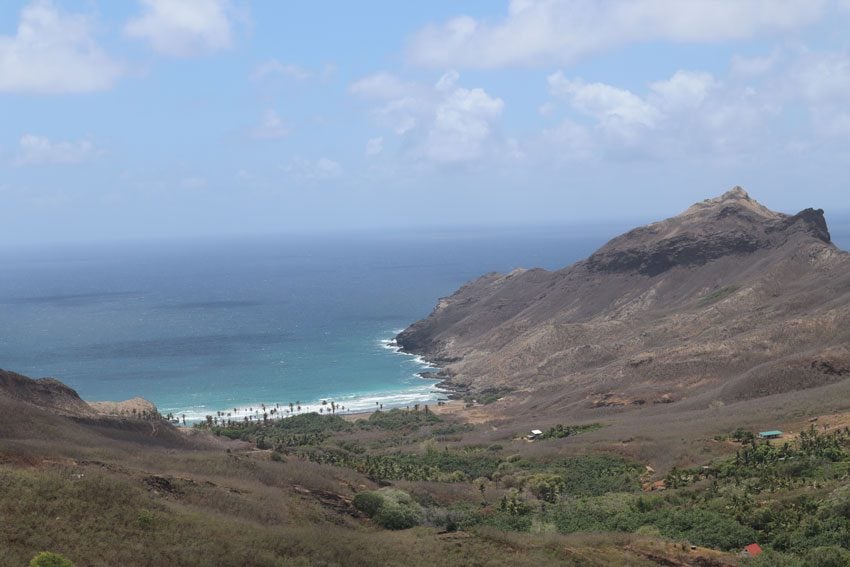
We stopped for a picnic lunch at Flower Beach, named so after the peculiar rock that can be found if you search hard enough. This rock is unique to Ua Pou and Brazil, used by local sculptures to create masterpieces which we’ll later see in the village. There wasn’t another soul around on this day, just the three of us, the crashing waves, and Jerome’s endless interesting stories.
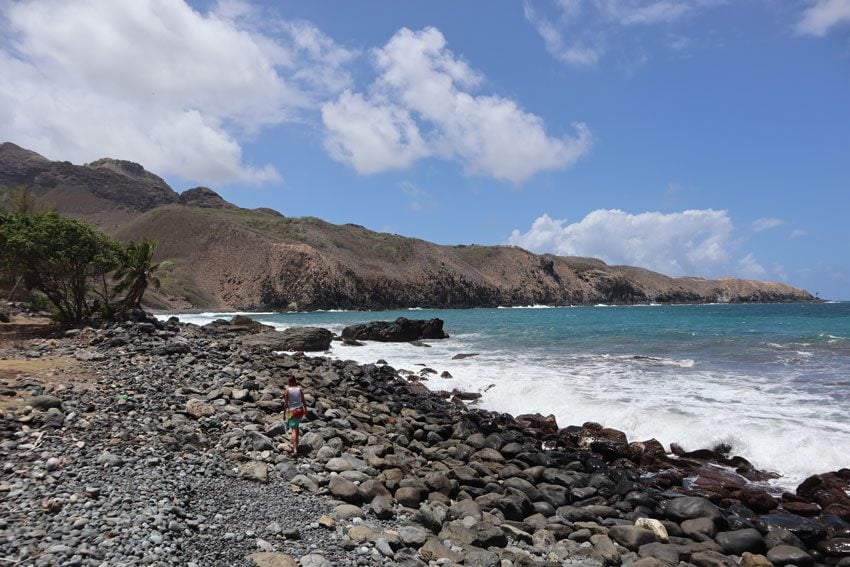
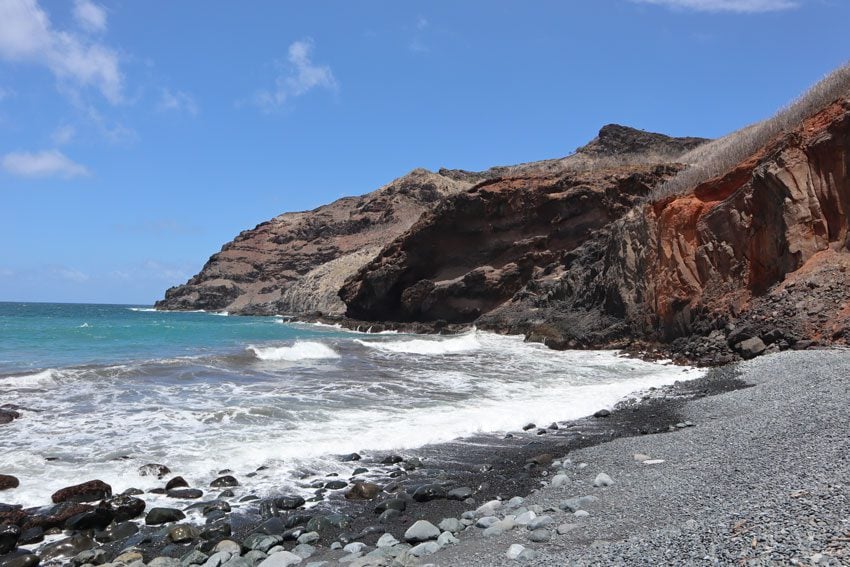
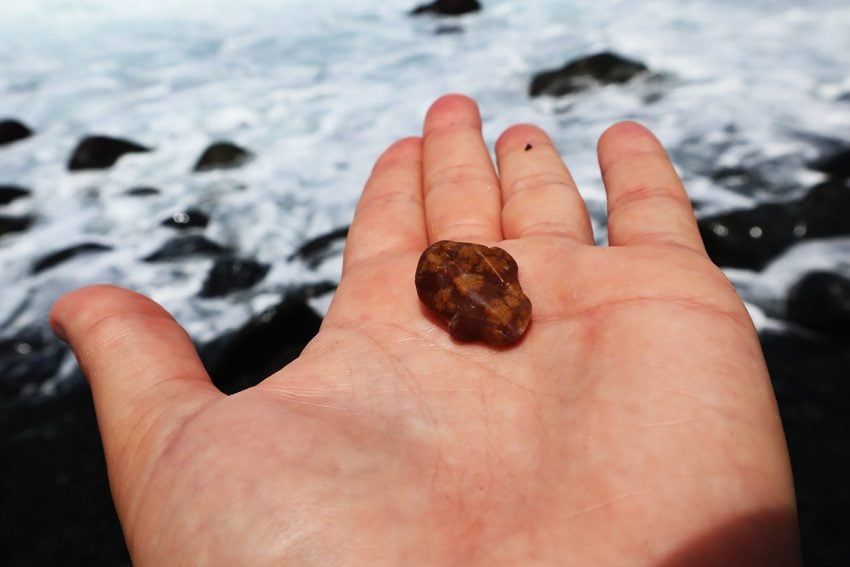
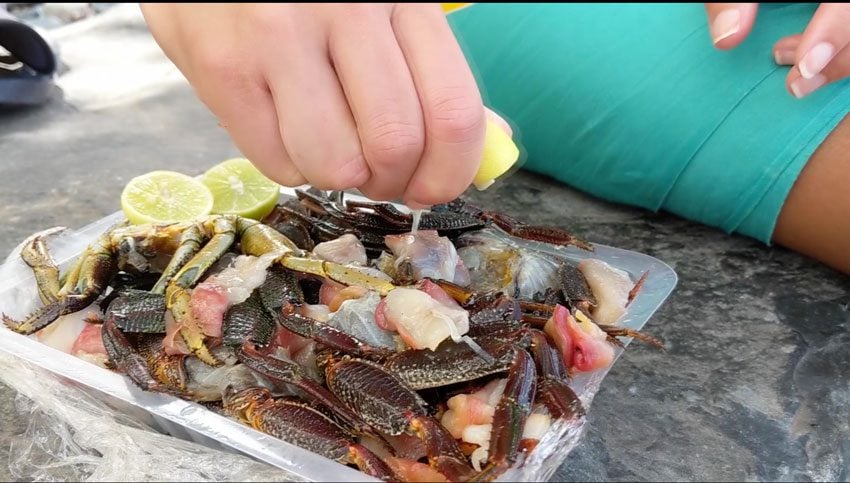
Our next stop was further inland, where the scenery became greener and rich with towering coconut palms. Many peapea (ancient ritual sites) have been discovered in Ua Pou but none are grander than Tohua Mauia. Restored for the 2019 Marquesan Arts Festival, this complex contains hand-made stone structures over 100 meters long, highlighting the importance of the place to the 1,500 estimated native population that is believed to have resided in this valley during pre-missionary days. Don’t be impressed by my facts though, this is all Jerome’s doing. He walked us along the various structures and statues, explaining about all the rituals that once took place here.
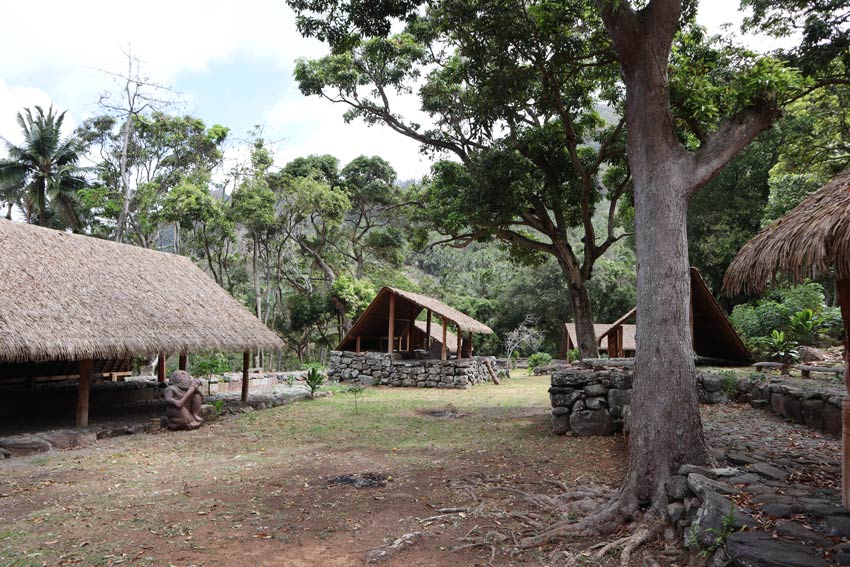
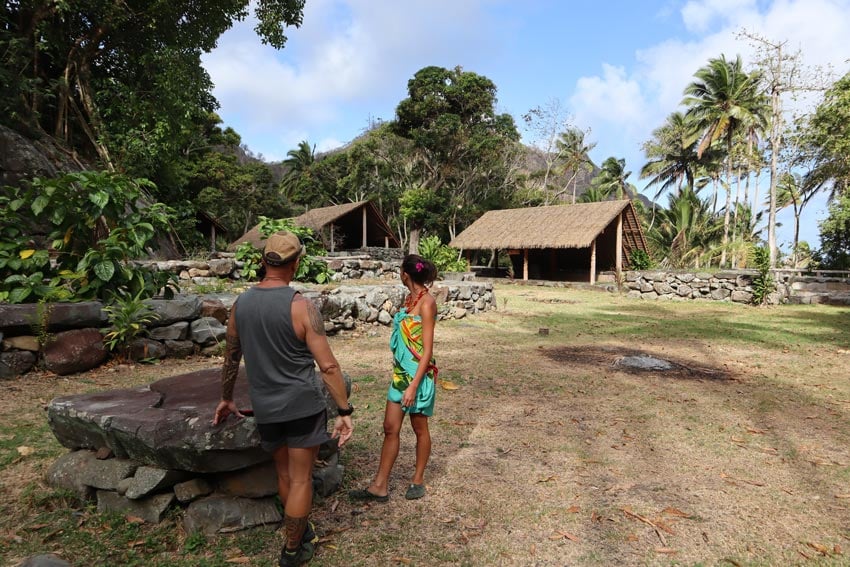
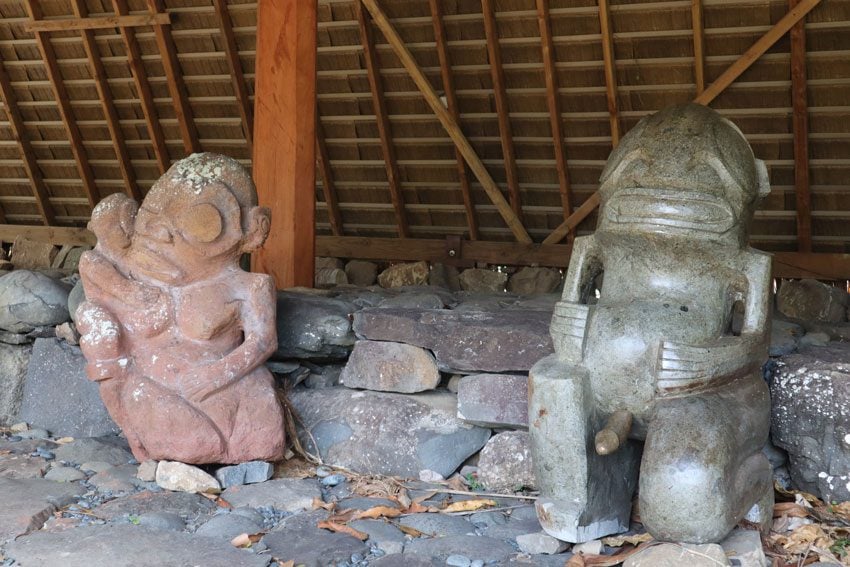
Many forms of peapea exist on the islands. Some were used as dancing platforms, some for the chief’s home, and some were used as meae – religious platforms which some locals are still scared to step on. This is an example of the pseudo-Christianity that exists in the Marquesas Islands. Though Christian, some locals are still afraid of the old ways, times where their social class was not allowed to enter such tapu (taboo) areas.
Our final stop was at the end of the road in the sleepy village of Hakatao, which means “bay of many taro”. It was a beautiful drive down there with the sun piercing through the canopy of a thick coconut grove. From the village, Jerome led us on a short hike over and down a cliff overlooking the village. What awaited us on the other side was truly a sight for sore eyes, a towering pinnacle rising 240 from the ocean. It’s called Cathedral Motu and with a flatter section behind it, it certainly looks like a grand place of worship for Mother Nature.
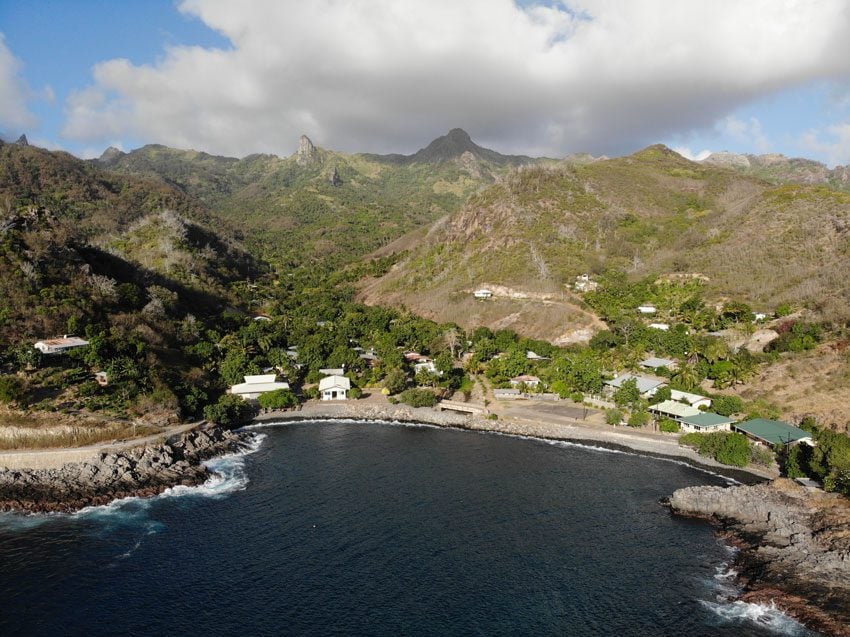
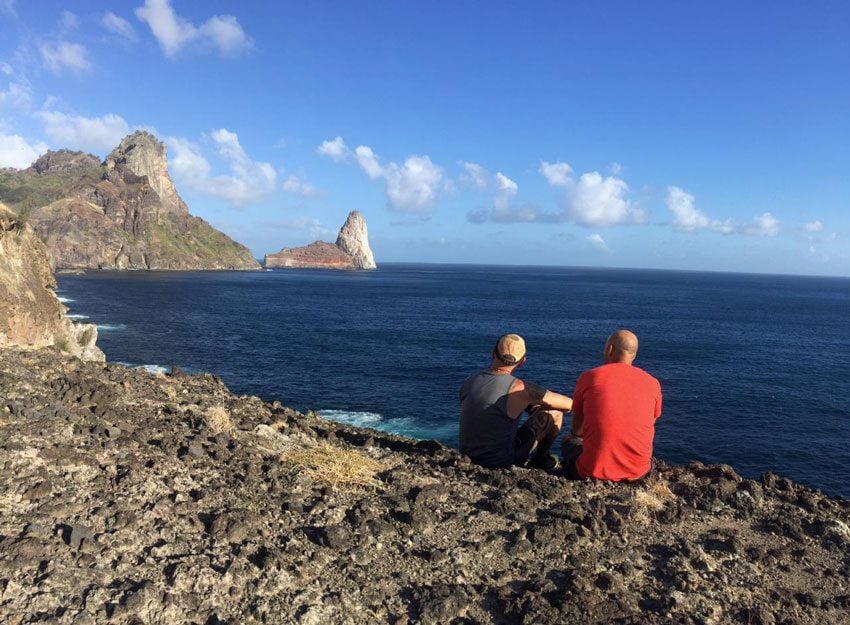
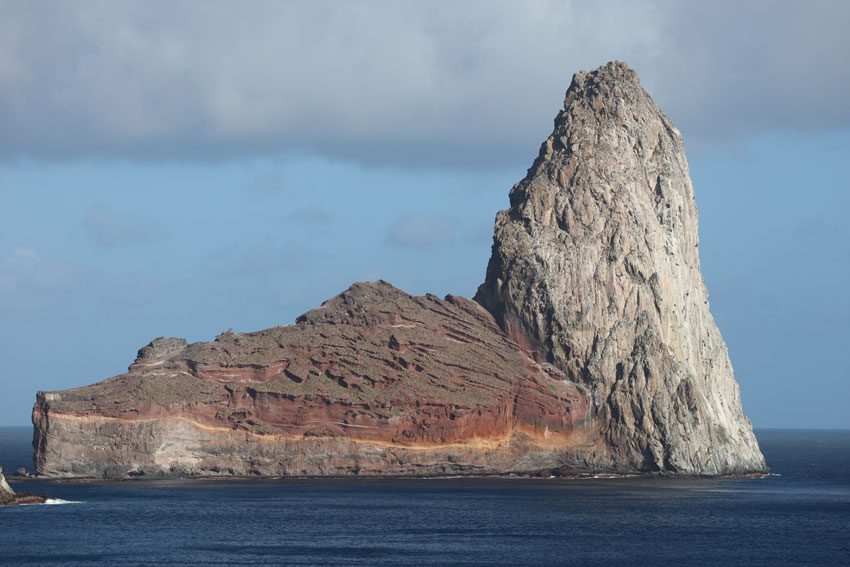
West Coast Roadtrip
With the eastern and southern sections covered, we rented our own 4X4 for the day and headed west. We stopped in Hakahau village to stock up on some food for the day and also to purchase some original souvenirs from the local artist market.
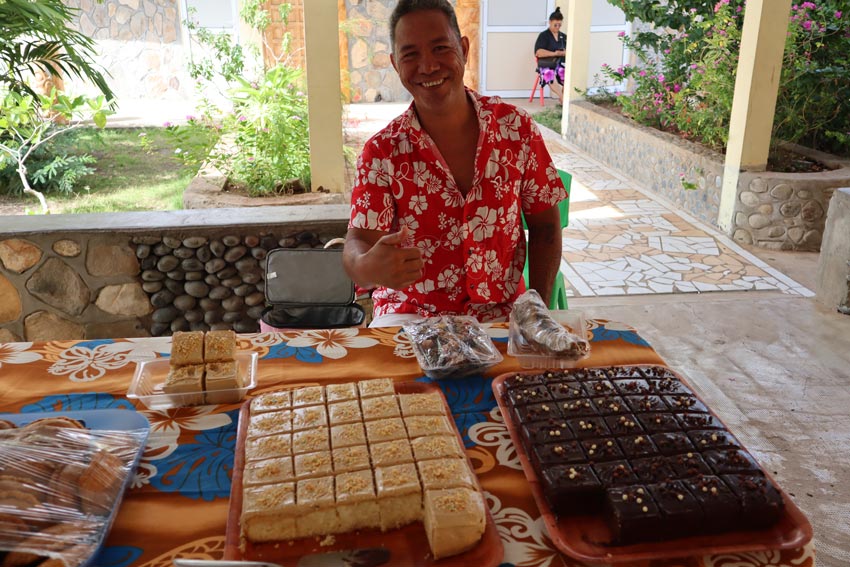
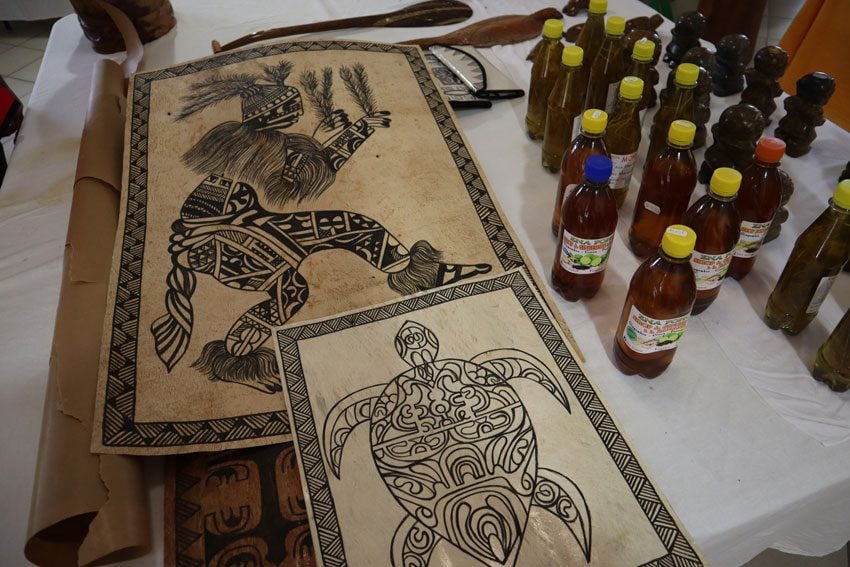
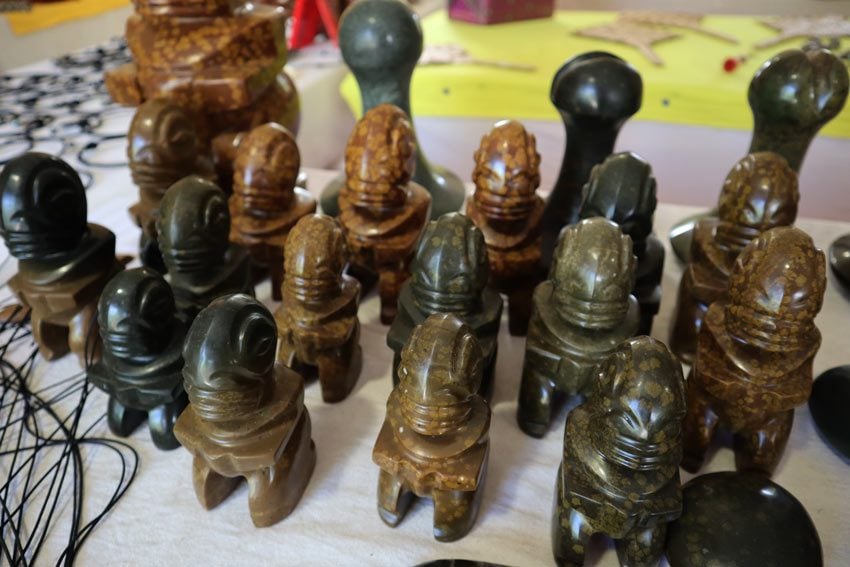
Just after the airport, the sealed road turned into dirt and that would be the driving condition for the remainder of the day. Our first stop was at Hakanai Bay, better known as Shark Beach. We originally planned to drive to the end of the road without stopping and working our way back but we just couldn’t resist stopping here upon the first sight of this wild beach.
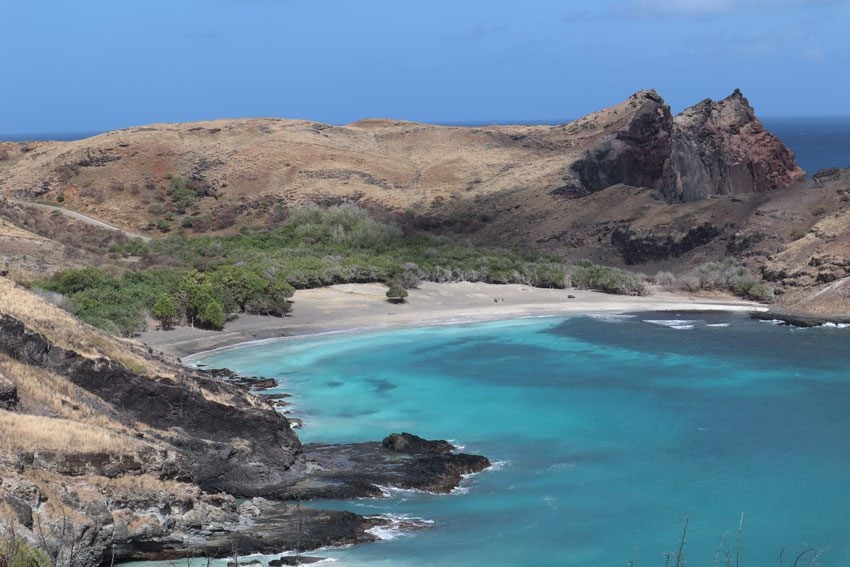
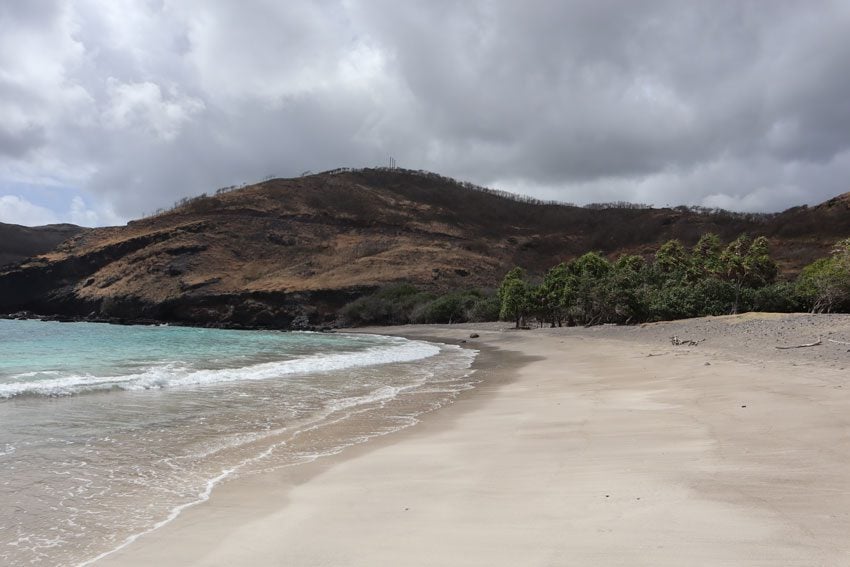
Our goal was to reach the village of Hakamaii but there were so many beautiful distractions along the way. The narrow one-lane dirt road twisted its way along beautiful scenery, begging us to stop and admire wild coastal views and rare clear vistas of the pinnacles.
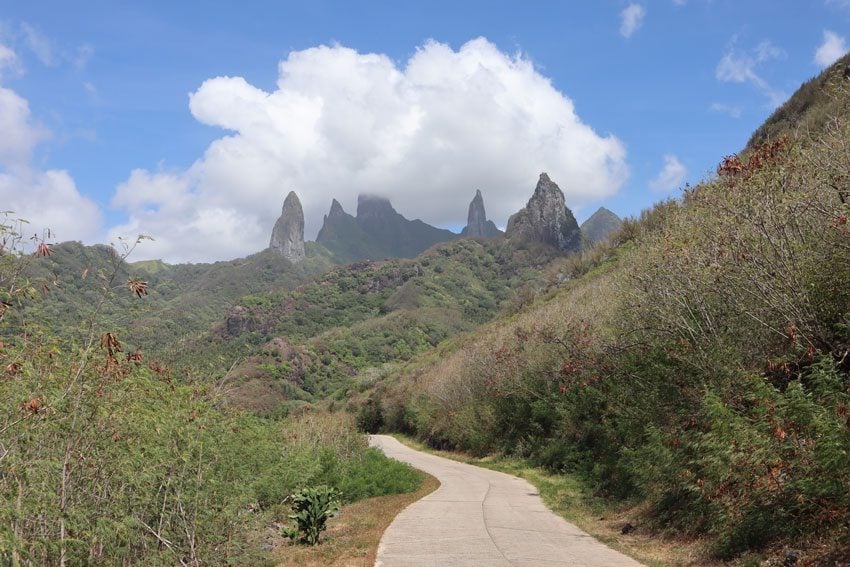
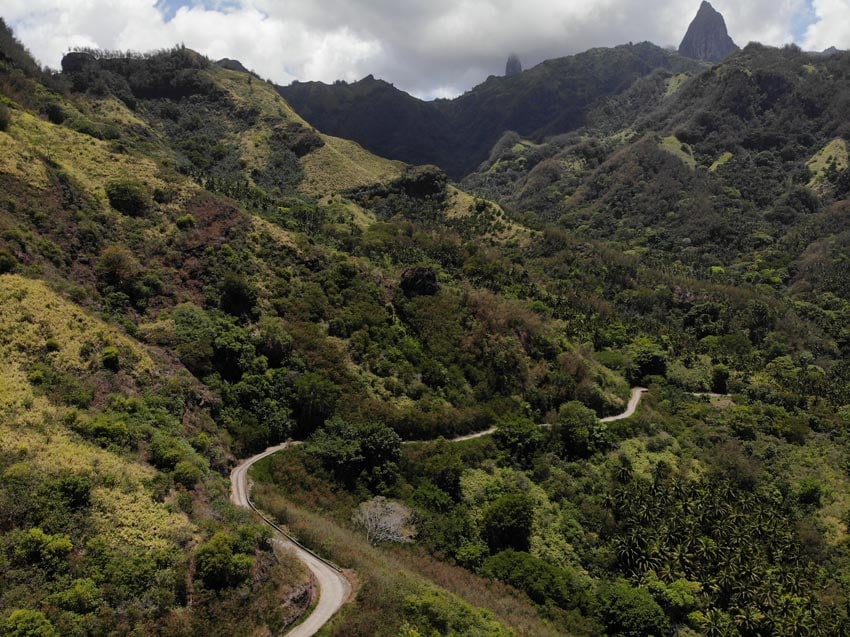
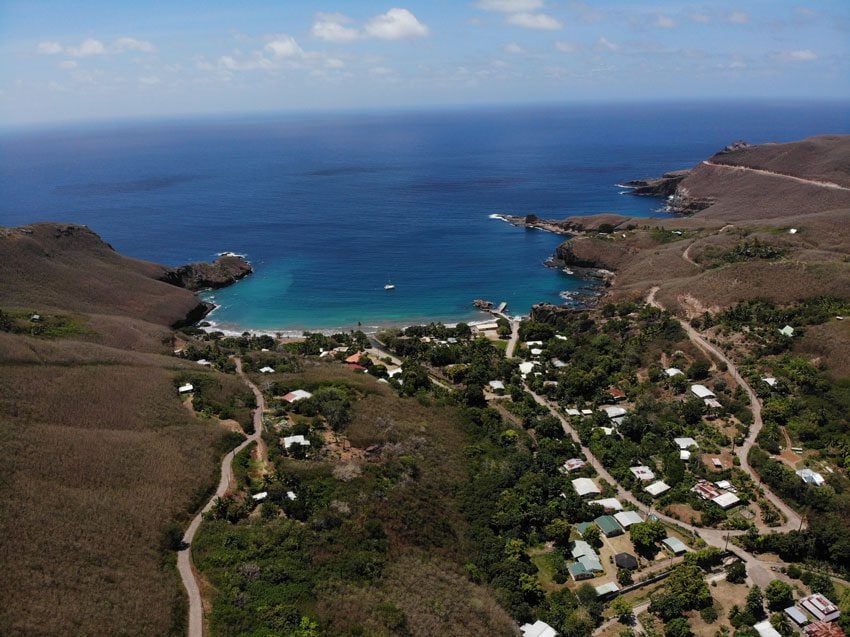
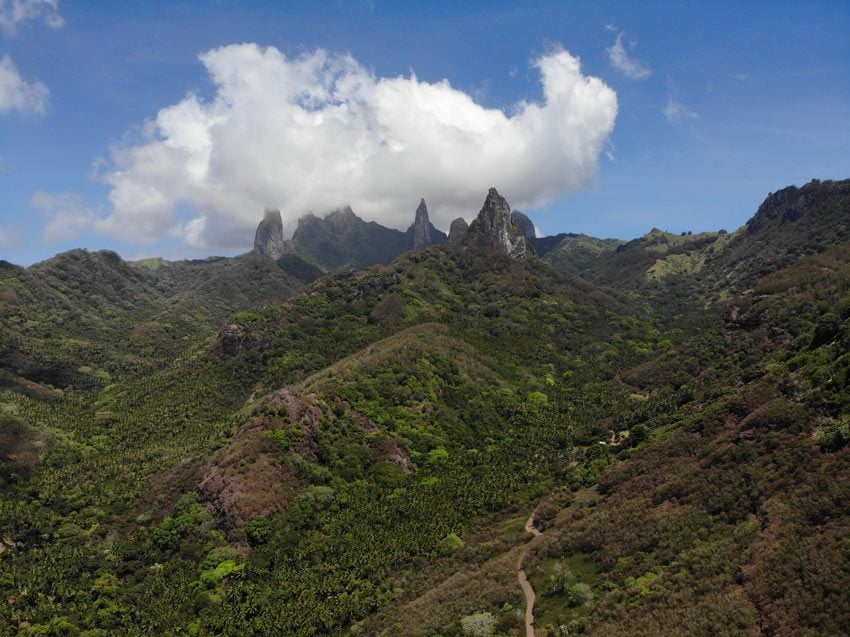
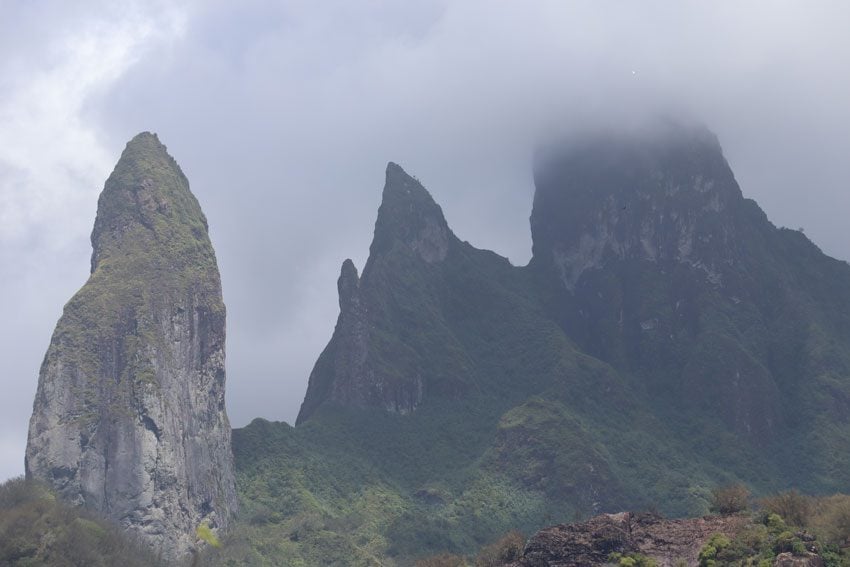
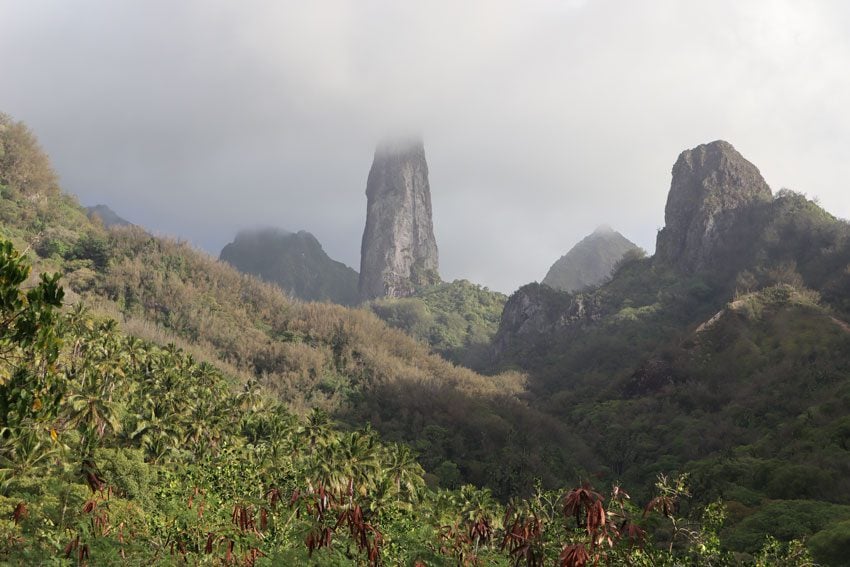
We reached the end of the road at Hakamaii and discovered it to be yet another gorgeous but sleepy village. So we got our hands on a couple of large pomelos and took a nap by the beach. When we woke up, a couple of fishermen were braving the waves and going out to sea to catch tonight’s dinner and maybe some change for a couple of Hinano beers.
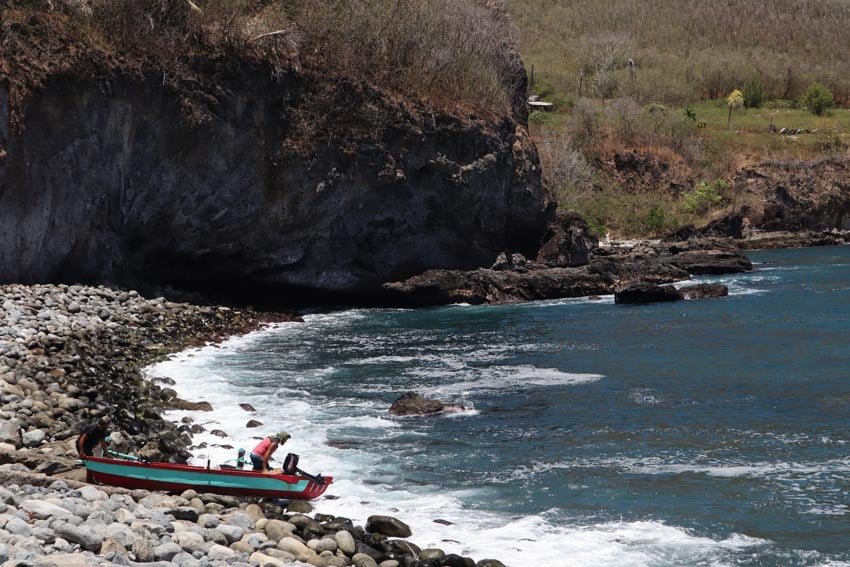
Now heading back in the direction of the pension, we entered the rainforest on a short hike to Cascade Vaiea. This isn’t the highest waterfall in French Polynesia but the pool it splashes into and its lush surroundings, turn this place into something straight out of a commercial for a tropical-scented shampoo. Where I come from, such a place would be packed throughout the week but such is the reward in the South Pacific, having all this beauty for yourself.
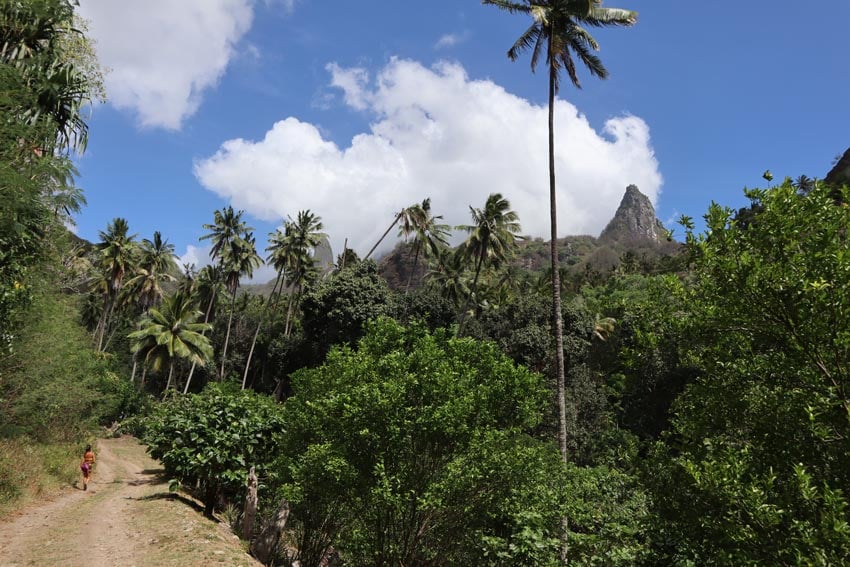
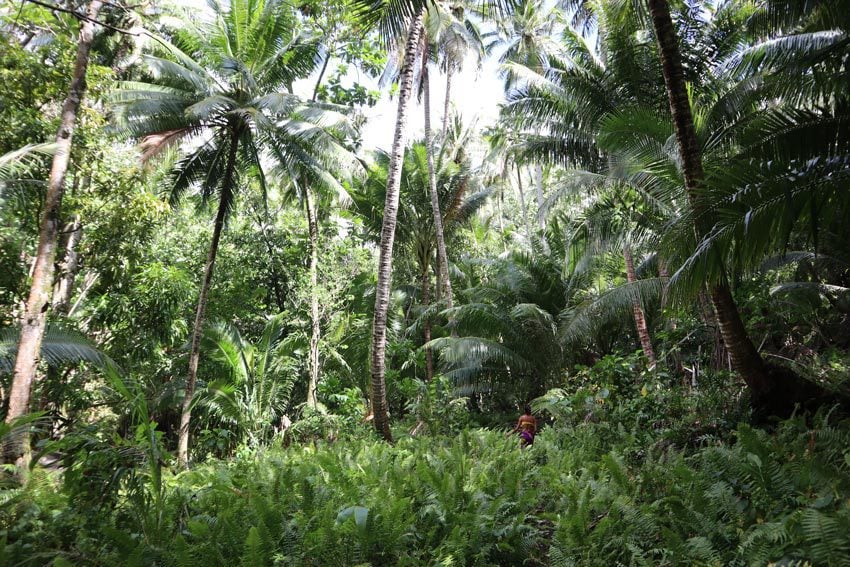
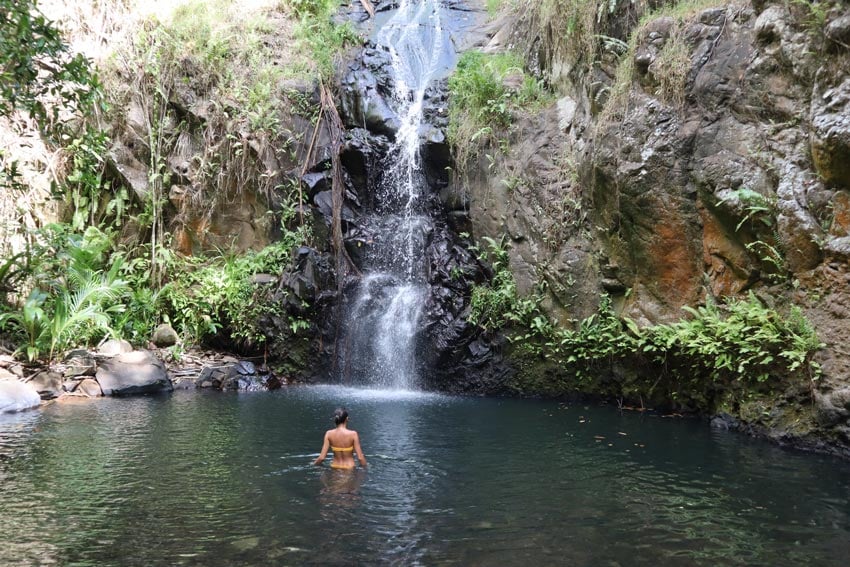
The drive back to Hakahau and the pension was interrupted only to enjoy yet another glorious sunset, a fitting end to a memorable road trip.
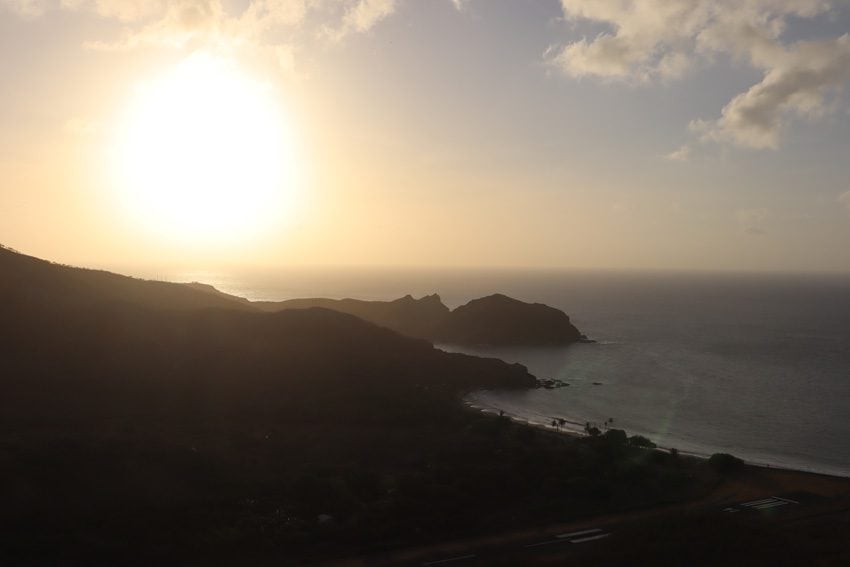
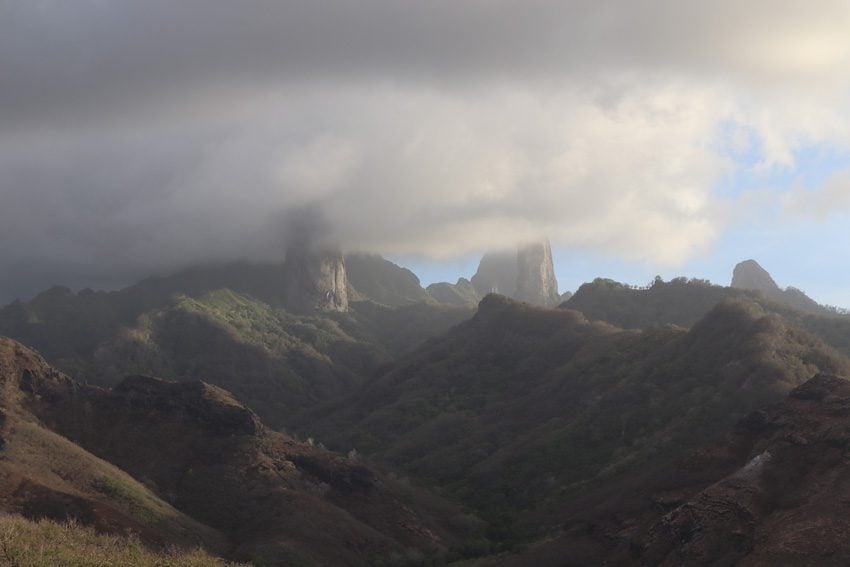
Hiking in Ua Pou
We got a very early start for our final day on the island. Our plan was to get as close as possible to the island’s basalt pinnacles on the Poumaka Peak hike. Dricia and I each packed a small bag, but Jerome’s military hiking bag seemed to contain all the necessities for any unforeseen calamity. It was a cloudy and somewhat chilly morning, and the 600 meters of altitude that would be gained meant it was best to suck it up and keep hiking.
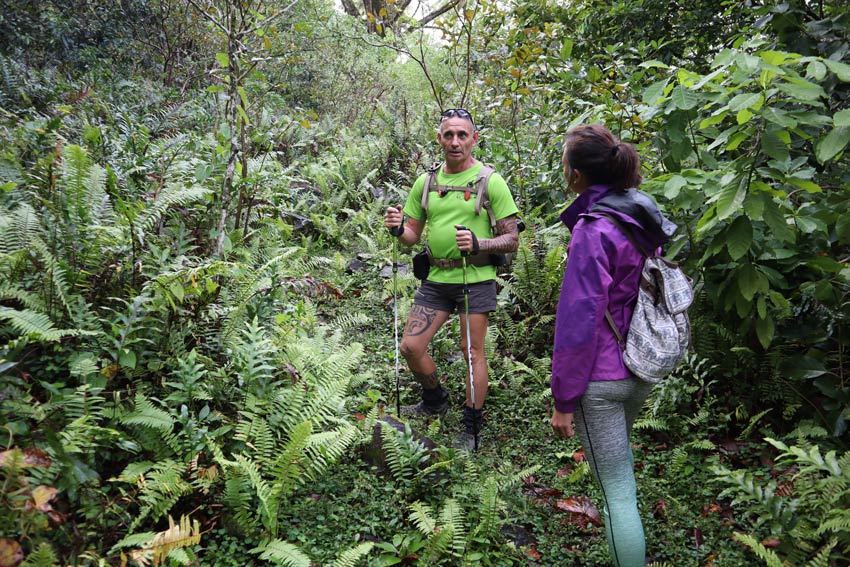
The trail started in the thick rainforest. Mosquitos were all over the place except on Jerome. I thought the whole “fresh-tourist-blood-thing” was an urban legend but I guess it’s not. As we started the climb, Jerome paused from time to time and showed us the various species of flora in the jungle and its uses. There were medicinal plants, wild vanilla, and coffee, massive banyan trees, grapefruit, and bushes that can be used to craft a shelter. If I must get lost in the rainforest with someone, that someone must be Jerome!
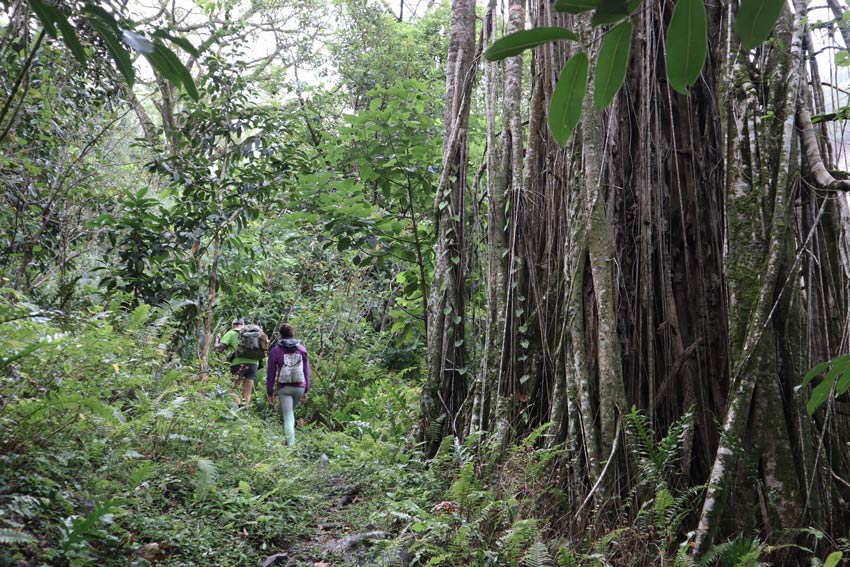
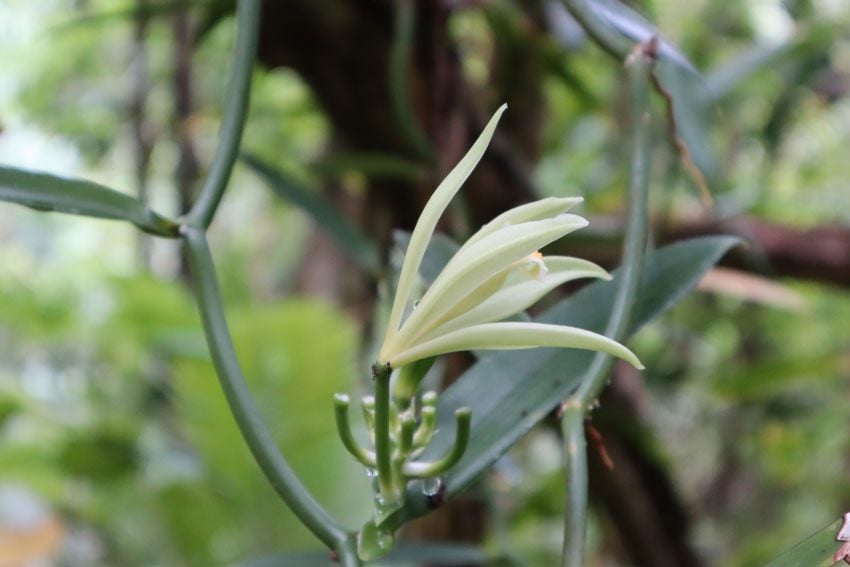
We had to negotiate a few tough sections using a rope but the effort was worthwhile when we saw the view from the highest section of the trail. You can’t get closer to the pitons than this. Admiring them from this close brings out features that can’t be seen from the coast. Poumaka rises like a needle to a height of 919 meters but its neighbor, Oave, is the highest point in the entire archipelago at 1,230 meters.
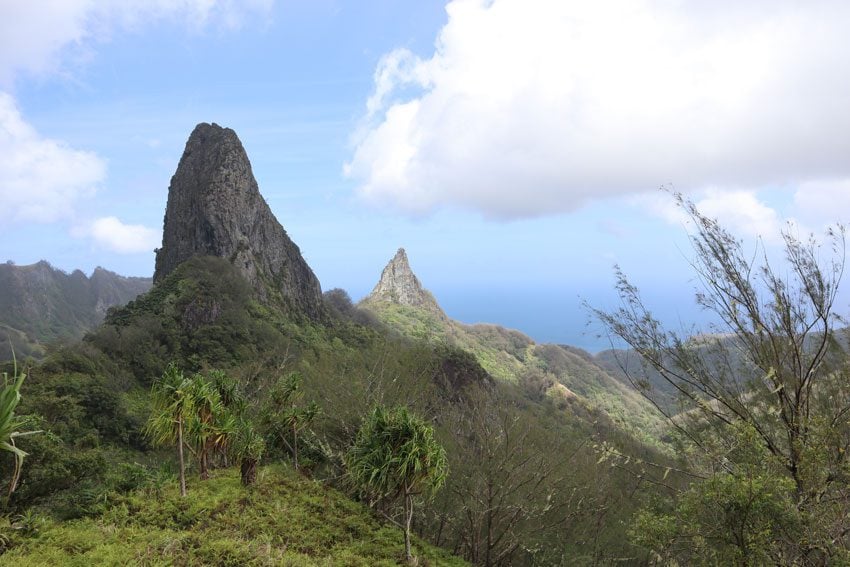
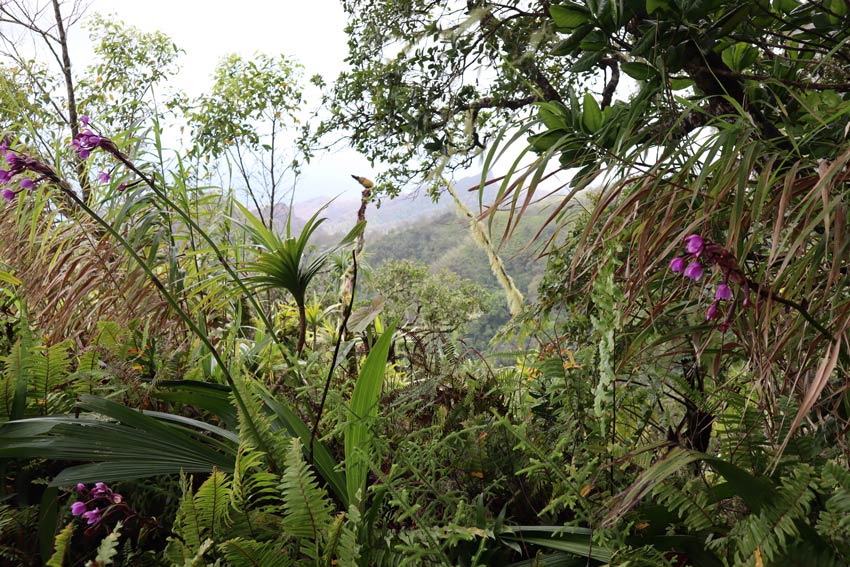
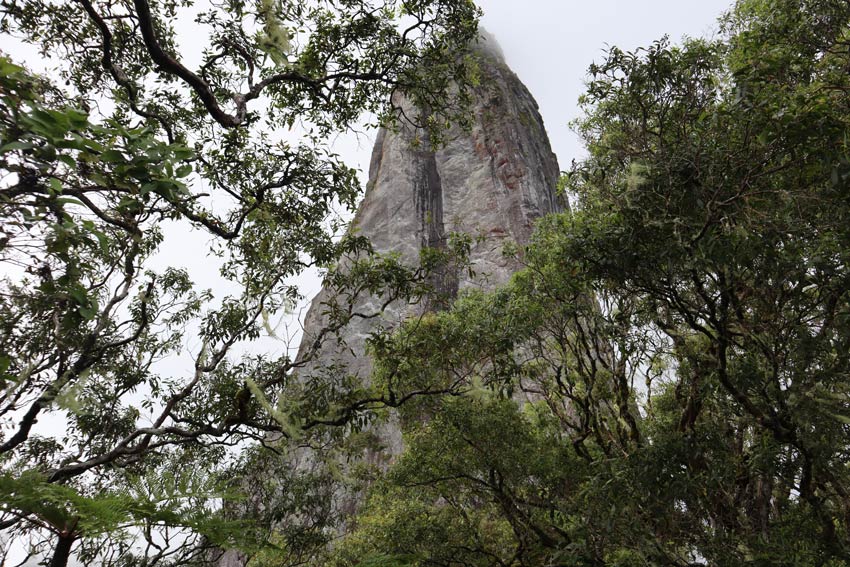
What goes up must also come down and on this trail, it meant descending back to level ground via a beautifully thick forest of giant pandanus. We celebrated the end of four memorable days in Ua Pou with lunch at Snack Ti’Piero in Hakahetau Village. As you can see from the image, there was a lot of food served and it was so well prepared. Among the various dishes, there was grilled tuna, breadfruit chips and poisson cru. Despite Jerome’s interesting tales, after such a meal and a hike, both Dricia and I collapsed in the Land Rover on the way back to the pension.
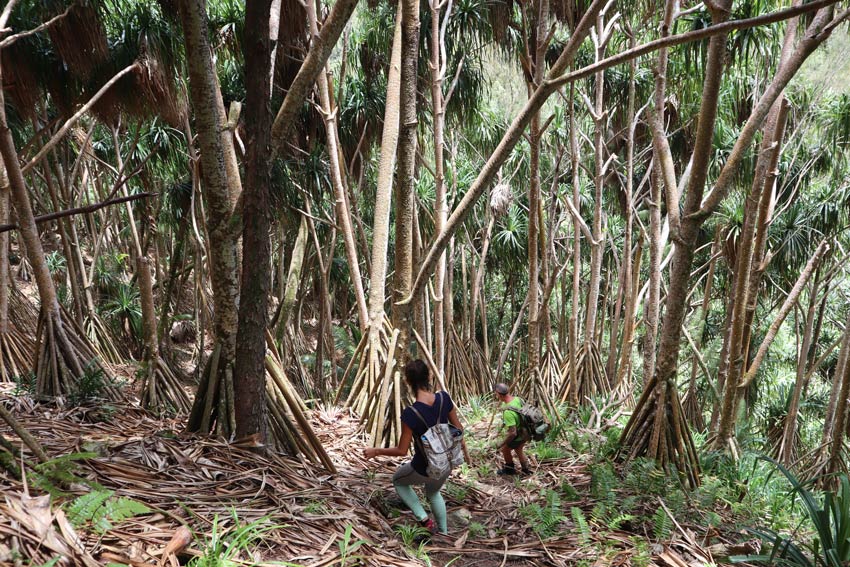
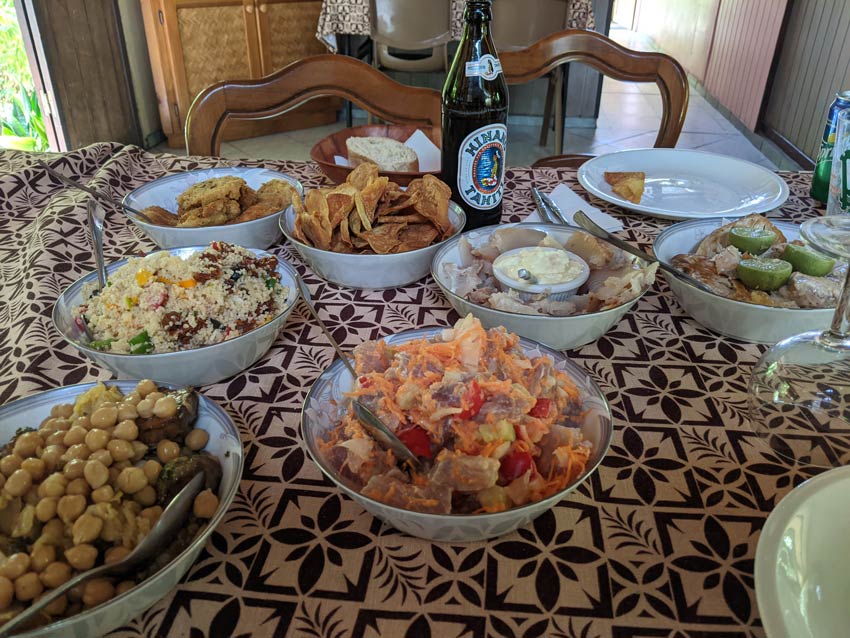
What’s Next?
In the last post in the series, we’ll head to the wildest and most majestic stop in the Marquesas Islands. Nuku Hiva is the stuff dreams are made of, an island so dramatic, that you would expect to see dinosaurs roaming the land. I spent a few days here back in March of 2016 and can’t wait to return.
>> Read the next post from Nuku Hiva >>
Tahiti, Tailor Made!
The Islands of Tahiti are among the last places to be colonized by mankind, 118 islands, each with its unique personality.
Get expert advice and assistance with planning your trip to the destination where tropical dreams come true!
